

Zitierweise / cite as:
Payer, Alois <1944 - >: Chronik Thailands = กาลานุกรมสยามประเทศไทย. -- Chronik 1964 / B. E. 2507. -- Fassung vom 2017-03-17. -- URL: http://www.payer.de/thailandchronik/chronik1964.htm
Erstmals publiziert: 2012-10-02
Überarbeitungen: 2017-03-17 [Ergänzungen] ; 2016-12-06 [Ergänzungen] ; 2016-11-21 [Ergänzungen] ; 2016-09-23 [Ergänzungen] ; 2016-08-31 [Ergänzungen] ; 2016-07-06 [Ergänzungen] ; 2016-05-23 [Ergänzungen] ; 2016-05-09 [Ergänzungen] ; 2016-04-07 [Ergänzungen] ; 2016-03-23 [Ergänzungen] ; 2016-02-20 [Ergänzungen] ; 2016-01-08 [Ergänzungen] ; 2015-12-06 [Ergänzungen] ; 2015-08-16 [Ergänzungen] ; 2015-07-10 [Ergänzungen] ; 2015-06-30 [Ergänzungen] ; 2015-02-07 [Ergänzungen] ; 2014-11-21 [Ergänzungen] ; 2014-11-10 [Ergänzungen] ; 2014-10-12 [Ergänzungen] ; 2014-09-10 [Ergänzungen] ; 2014-08-19 [Ergänzungen] ; 2014-04-01 [Ergänzungen] ; 2013-12-09 [Ergänzungen] ; 2013-11-21 [Ergänzungen] ; 2013-11-07 [Ergänzungen] ; 2013-10-27 [Ergänzungen] ; 2013-10-22 [Ergänzungen] ; 2013-10-05 [Ergänzungen] ; 2013-09-30 [Ergänzungen] ; 2013-09-25 [Ergänzungen] ; 2013-09-16 [Ergänzungen] ; 2013-08-19 [Ergänzungen] ; 2013-06-04 [Ergänzungen] ; 2013-05-20 [Ergänzungen] ; 2013-04-03 [Ergänzungen] ; 2013-03-28 [Ergänzungen] ; 2013-03-18 [Ergänzungen] ; 2013-01-23 [Ergänzungen] ; 2013-01-12 [Ergänzungen]
©opyright: Dieser Text steht der Allgemeinheit 2013-02-14 [Ergänzungen] ; zur Verfügung. Eine Verwertung in Publikationen, die über übliche Zitate hinausgeht, bedarf der ausdrücklichen Genehmigung des Herausgebers.
Dieser Text ist Teil der Abteilung Thailand von Tüpfli's Global Village Library
ช้างตายทั้งตัวเอาใบบัวปิดไม่มิด
|
Gewidmet meiner lieben Frau Margarete Payer die seit unserem ersten Besuch in Thailand 1974 mit mir die Liebe zu den und die Sorge um die Bewohner Thailands teilt. |
|
Bei thailändischen Statistiken muss man mit allen Fehlerquellen rechnen, die in folgendem Werk beschrieben sind:
Die Statistikdiagramme geben also meistens eher qualitative als korrekte quantitative Beziehungen wieder.
|
| Statistik: US-Militärs in Thailand: 6.000 Nichtmilitärische Hilfe der USA 1960 - 1964: $112 Mio. Publizierte Buchtitel: 4.198 Kommerzelle Buchverlage: 5 Anzahl der Druckereien: 789 |
1964
Stand der außenpolitischen Verträge:
Verträge über Freundschaft, Handel und Schifffahrt mit:
Belgien
Dänemark
Frankreich
Italien
Japan
Luxemburg
Niederlande
Norwegen
Portugal
Sowjetunion
Schweiz
Großbritannien
USA
Freundschaftsverträge mit:
Republik China (Taiwan)
Indonesien
Philippinen
Burma
Handelsverträge mit:
Argentinen
Japan
Laos
Südkorea
Thailand bekommt Wirtschaftshilfe und technische Hilfe von:
Australien
Republik China (Taiwan)
Dänemark
Frankreich
Bundesrepublik Deutschland
Japan
Neuseeland
Schweden
Großbritannien
USA
einige weitere Länder
Abb.: Der wichtigste Vertragspartner Thailands: USA
[Bildquelle: CIA. -- Public domain]
Abb.: Vertragspartner Thailands in Südostasien
[Bildquelle: CIA. -- Public domain]
Abb.: Vertragspartner Australien und Neuseeland
[Bildquelle: CIA. -- Public domain]
Abb.: Vertragspartner Thailands in Europa
[Bildquelle: San Jose / Wikipedia. -- GNU FDLicense]
Abb.: Vertragspartner Sowjetunion, Burma, Republik China (Taiwan), Südkorea, Japan
[Bildquelle: CIA. -- Public domain]
Abb.: Vertragspartner Thailands in Südamerika
[Bildquelle: CIA. -- Public domain]
Abb.: Medizinisches Gerät als Entwicklungshilfe von Schweden, ca. 1967
1964 - 1966

Three-Year-Development Plan, weitgehend von den USA finanziert
Abb.: Dreijahres-Entwicklungsplan 1964 - 1966, Anteile am Gesamtbudget von 19,4 Milliarden Baht
[Datenquelle: Luther, Hans Ulrich <1940 - >: Peasants and state in contemporary Thailand : from regional revolt to national revolution?. -- Hamburg : Institut für Asienkunde, 1978. -- 109 S. ; 21 cm. -- (Mitteilungen des Instituts für Asienkunde, Hamburg ; Nr. 98). -- ISBN 3-921469-49-X. -- S. 89]
1964

Von den USA initiiertes Community Development Program
"Official sources described the aims of the community development program as follows:
- general improvement of the agrarian sector
- improvement of agricultural planting and harvesting methods improvement of the standard of living in the rural areas
- education and training for the peasants especially organizing "mutual help" programs
- establishment of an organizational network in the countryside whose members are loyal to the government and have pledged to stop subversion and infiltration by communists
By introducing this network of new organizations the diffuse and informal structure of village communities was to be reformed and re-oriented towards a tightly controlled rural society. The CD-workers (patanakorn [พัฒนาการ]) in this new framework became the "counterparts" of communist organizers. They tried to counter the united-front strategy of the communists by developing a "free and democratic village society". The most important new forms of organization on the village level were as follows:
- Village self-defence unit (yahm [ยาม]) against robbers, cattle thieves and "communists", armed with guns and a portable wireless receiver
- council of village elders (kamakarn muban [กรรมการหมู่บ้าน])
- village co-operative providing loans and credits
- committee for village development
- committee for education and the village school
- committee for health problems
- committee for maintaining the village temple
- committee for agricultural problems
Though these programs did not "trickle down" to most of the villages, they certainly had an impact on the region."
[Quelle: Luther, Hans Ulrich <1940 - >: Peasants and state in contemporary Thailand : from regional revolt to national revolution?. -- Hamburg : Institut für Asienkunde, 1978. -- 109 S. ; 21 cm. -- (Mitteilungen des Instituts für Asienkunde, Hamburg ; Nr. 98). -- ISBN 3-921469-49-X. -- S. 91f. -- Fair use]
1964

10 Thai besuchen die Politische Schule der Kommunistischen Partei Chinas (中國共產黨 / 中国共产党) in Zhongnanhai (中南海), Peking.
Abb.: Lage von Zhongnanhai (中南海)
[Bildquelle: OpenStreetMap. -- Creative Commons Lizenz (Namensnennung, share alike)]
1964
Wasserführung des Chao Phraya (แม่น้ำเจ้าพระยา) bei Nakhon Sawan (นครสวรรค์):
Abb.: Wasserführung des Chao Phraya (แม่น้ำเจ้าพระยา) bei Nakhon Sawan (นครสวรรค์), 1964 (m³ Wasser / Sekunde)
[Datenquelle: Statistical yearbook 1967 - 1969, S. 24f.]
Abb.: Lage von Nakhon Sawan (นครสวรรค์)
[Bildquelle: Wikipedia. -- Public domain]
Abb.: Beginn des Chao Phraya (แม่น้ำเจ้าพระยา) bei Nakhon Sawan (นครสวรรค์), 2003
[Bildquelle: Heinrich Damm / Wikimedia. -- GNU FDLicense]
1957 - 1966
Genossenschaften zur Verbesserung des Bewässerungslandes (Land Improvement Cooperatives):
Abb.: Genossenschaften zur Verbesserung des Bewässerungslandes (Land Improvement Cooperatives), 1957 - 1966
[Datenquelle: Thailand official year book 1968. -- S. 388]
1964
National Forest Reserve Act B.E. 2507. Dieses Gesetz schafft die Grundlage, dass Bauern aus (meist abgeholztem) Waldland, das zur Forest Reserve erklärt wurde, vertrieben werden können.
1964

Die Königinmutter (ศรีนครินทร์, 1900 - 1995) gründet den Volunteer Flying Doctors Service (VFDS, มูลนิธิแพทย์อาสาสมเด็จพระศรีนครินทราบรมราชชนนี - พอ.สว.) zur medizinischen Versorgung entlegener Gegenden. 1973 wird der VFDS über 700 Flüge machen und ca. 250.000 Personen behandeln. Vorbild ist der Royal Flying Doctor Service of Australia (RFDS)
Abb.: ®Logo
[Bildquelle: Looknarm / th.Wikipedia. -- GNU FDLicense]
1964
Der Staat beginnt den Kult verschiedener "Freiheitshelden" Thailands zu fördern z.B. in Chayaphum (ชัยภูมิ) das jährliche Fest für den Chaopho Phraya Lae (เจ้าพ่อพญาแล = พระยาภักดีชุมพล), der angeblich König Anuvong (ສົມເດັຈພຣະເຈົ້າອານຸວົງສ໌ - เจ้าอนุวงศ์, 1767 - 1829) von Vientiane (ວຽງຈັນ) Widerstand geleistet hat (in Wirklichkeit stand Chaopho Phraya Lae auf Seiten Anuvongs).
Abb.: Lage von Chayaphum (ชัยภูมิ)
[Bildquelle: OpenStreetMap. -- Creative Commons Lizenz (Namensnennung, share alike)]
Abb.: Plakat für das Fest 2014
[Fair use]
1964
Es erscheint:
Montrakun, Sarot ; Pendleton, Robert Larimore <1890 - 1957>: Agriculture and soils of Thailand : compilation of soil reports and laboratory analysis of the soils in Thailand. -- [Bangkok, Thailand] : Technical Division, Dept. of Rice, Ministry of Agriculture, 1964.
Abb.: Einbandtitel
1964
Es erscheint:
Report of an assessment of the National Malaria Eradication Project of Thailand / Lee M. Howard and others. -- Bangkok : Agency for International Development, USOM/Thailand [and] Communications Media Division, 1964. -- 100 S. : Illustrations ; 28 cm
"While scattered efforts have been made in past years to determine vector species susceptibility to DDT, no records of such work or results are available. Expression is made of the difficulty of obtaining adequate numbers of specimens with which to carry out scientific susceptibility tests. The Project operates on the assumption that no DDT resistance exists in Thailand. . . . Some of the zone chiefs and assistant zone chiefs have acquired considerable competence in mosquito identification and interpretation of vector density." [Zitiert in: Siffin, William J. <1922 - 1993>: The Thai bureaucracy: institutional change and development. -- Honolulu : East-West Center, 1966. -- 291 S. ; 24 cm. -- S. 209. -- Fair use]
1964
Fertigstellung der Bang Chak Erdölraffinerie, Bang Chak (บางจาก), Bangkok.
Abb.: Lage von Bang Chak (บางจาก)
[Bildquelle: OpenStreetMap. -- Creative Commons Lizenz (Namensnennung, share alike)]
Abb.: Erdölraffinerie Bang Chak (บางจาก), ca. 1967
1964

Gründung von Thai-Asahi Caustic Soda (ab 1988: THASCO Chemical Co., Ltd. ; ab 2007: AGC Chemicals (Thailand) Co.,Ltd), ein Joint Venture zwischen Asahi Glass Co., Ltd. (旭硝子), Japan und Thai-Unternehmern, vor allem General Pramarn Adireksarn (พลเอก พลตำรวจเอก ประมาณ อดิเรกสาร , 1913 - 2010). Thai-Asahi Caustic Soda wird der einzige Lieferant für Chlor zur Trinkwasserdesinfektion für das Department of Public Works.
1964
Inlandluftverkehr: der Luftverkehr im Inland wird von der staatlichen Thai Airways Co., Ltd. betrieben. Sie hat sieben DC-3 mit je 28 Sitzen. Drei AVROS-748 mit je 40 Sitzen sind bestellt.
Abb.: Inlandflugverkehr pro Woche, 1964
[Datenquelle: Thailand official year book 1964. -- S. 357]
Abb.: Inlandflugverkehr pro Woche, 1964
[Datenquelle: Thailand official year book 1964. -- S. 357]
1964

Über den positiven Einfluss des Königs auf die Leichtathletik:
"His Majesty the King is especially interested in athletic contests. He attends the annual athletic tournament every year unless kept away by an urgent and important engagement. He often speaks about the spectators. Being himself keen on statistics he is of the opinion that Thai athletes could and should be able to achieve respectable records in athletics. Thanks to His Majesty the King, this serves as a wonderful inspiration and a morale booster to all persons concerned in the athletic movement." [Quelle: Thailand official year book 1964. -- S. 645.]
1950 - 1969
Import von Traktoren für die Landwirtschaft:
Abb.: Import von Traktoren für die Landwirtschaft, 1950 - 1969
[Datenquelle: Ingram (1971), S. 272]
Abb.: Ein Zeugnis vergangener Zeiten: Traktor, Phuket (ภูเก็ต), 2006
[Bildquelle: Evan HB. -- http://www.flickr.com/photos/akumaprime/222168377/. -- Zugriff am 2012-02-16. -- Creative Commons Lizenz (Namensnennung, keine kommerzielle Nutzung, keine Bearbeitung)]
Abb.: Lage von Phuket (ภูเก็ต)
[Bildquelle: OpenStreetMap. -- Creative Commons Lizenz (Namensnennung, share alike)]Import von Kunstdünger:
Abb.: Import von Kunstdünger in Tonnen, 1950 - 1969
[Datenquelle: Ingram (1971), S. 272]
1964

Hino Motors Ltd. (日野自動車株式会社), die japanische Firma für Lastwagen und Busse, gründet Thai Hino Industry Co., Ltd und der ersten Montagefabrik in Samrong (สำโรง).
Abb.: ®Logo
Abb.: Lage von Samrong (สำโรง)
[Bildquelle: OpenStreetMap. -- Creative Commons Lizenz (Namensnennung, share alike)]
Abb.: Hino KM505, Ubon Ratchathani (อุบลราชธานี), 2010
[Bildquelle: Ilya Plekhanov / Wikimedia. -- Creative Commons Lizenz (Namensnennung, share alike)]
Abb.: Hino-Sogthaew (สองแถว), Sakon Nakhon (สกลนคร), 2007
[Bildquelle: Mattes / Wikimedia. -- Public domain]
Abb.: Hino-Bus, Bangkok, 2009
[Bildquelle: Ian Fuller. -- http://www.flickr.com/photos/18684820@N00/3880806365. -- Zugriff am 2013-10-14. -- Creative Commons Lizenz (Namensnennung, keine kommerzielle Nutzung)]
1964

Ausschnitte aus einem US-Film über die Ausbildung der Thai Special Forces:
[Quelle der .mp4-Filmausschnitte über die Ausbildung der Thai Special Forces: http://www.archive.org/details/gov.dod.dimoc.26105. -- Zugriff am 2012-03-13. -- Public domain]
1964

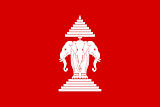
Abb.: Principal routes in Southern Laos, 1964
[Bildquelle: USAF / Van Staaveren, Jacob: Interdiction in southern Laos, 1960-1968 : the United States Air Force in Southeast Asia. -- Washington, D.C. : Center for Air Force History, 1993. -- 360 S. : Ill. ; 24 cm. -- S. 41. -- Public domain]
1964



Die USA setzen erstmals Teledyne Ryan Firebee Drohnen (RPV - remotely piloted vehicles) über Nord-Vietnam, Laos und China ein
Abb.: Teledyne Ryan Firebee Drohne aus dem Vietnamkrieg
[Bildquelle: USAF / Wikimedia. -- Public domain]
1964

Es erscheint:
Fall, Bernard B. <1926 - 1967>: The two Vietnams : a political and military analysis. -- New York : Praeger, 1964. -- 498 S. ; 22 cm
"Bernard B. Fall (November 19, 1926 – February 21, 1967) was a prominent war correspondent, historian, political scientist, and expert on Indochina during the 1950s and 1960s. Born in Austria, he moved with his family to France as a child after Germany's annexation, where he started fighting for the French Resistance at the age of sixteen, and later the French Army during World War II. In 1950 he first came to the United States for graduate studies at Syracuse University and Johns Hopkins University, returning and making his residence there. He taught at Howard University for most of his career and made regular trips to Southeast Asia to learn about changes and the societies. He predicted the failures of France and the United States in the wars in Vietnam because of their tactics and lack of understanding of the societies.
Early lifeBorn in Vienna, Austria, to Jewish parents Leo Fall and Anna Seligman, Bernard Fall and his family migrated in 1938 when he was a child to live in France, when Austria was annexed by Nazi Germany. After France fell to Germany in 1940, his father Leo Fall aided the French Resistance. Leon Fall was captured, tortured and killed by the Gestapo. His mother was also captured and deported to Auschwitz, where she died.
In 1942 at the age of sixteen, Bernard Fall followed in his father's footsteps and joined the French Resistance, after which time he fought the Germans in the Alps. As France was being liberated in 1944, Fall joined the French Army, in which he served until 1946. For his service, he was awarded the French Liberation Medal. Following World War II, Fall worked as an analyst for the Nuremberg War Crimes Tribunal, in which capacity he investigated Krupp Industries.
Academic careerFrom 1948 to 1949, Fall studied at the University of Paris. From 1949 to 1950, he attended the University of Munich.
After completing his studies in Europe, Fall traveled to the United States in 1950 on a Fulbright Scholarship, where he studied at the University of Maryland for a time. In 1951, Fall enrolled at Syracuse University, where he received a masters degree in political science in 1952. Fall did post-graduate study at the Johns Hopkins School for Advanced International Studies, where he was encouraged to study Indochina. Fall took the idea to heart.
Not content to study Indochina from afar, Fall traveled to Vietnam in 1953, when the First Indochina War was being waged between the Viet Minh and French Union forces. Due to his French citizenship, Fall was allowed to accompany French soldiers and pilots into enemy territory. From his observations, Fall predicted the French would fail in Vietnam. When the French were defeated in the critical Battle of Dien Bien Phu, Fall claimed the United States was partly responsible for France's loss. Fall believed that the United States had not supported France to a sufficient extent during the First Indochina War.
In 1954, Fall returned to the United States and married Dorothy Winer. In 1955, he earned a doctorate from Syracuse University and became an assistant professor at American University in Washington, DC.
In 1956, he began teaching international relations courses at Howard University, also in Washington. Fall became a full professor at Howard in 1962 and taught there intermittently until his death.
Never losing his interest in Indochina, Fall returned to the region five more times (in 1957, 1962, 1965, 1966, and 1967) to study developments firsthand. Fall was given a grant by the Southeast Asia Treaty Organization (SEATO) to study the development of communism in Southeast Asia. He used it to document the rise of communist activity in Laos. Fall was particularly interested in the tensions between North Vietnam and South Vietnam. While teaching at the Royal Institute of Administration in Cambodia in 1962, Fall was invited to interview Ho Chi Minh (1890 - 1969) and Phạm Văn Đồng (1906 - 2000) in Hanoi. Ho Chi Minh told Fall his belief that communism would prevail in South Vietnam in about a decade's time.
Fall was a political scientist, but one who had been a soldier and who spoke the soldier's language and lived the soldier's life at the front line. He obtained his data on the war while slogging through the mud of Vietnam with French colonial troops, with American infantry, and with South Vietnamese soldiers. He combined the usual academic analysis of Indochina with a perspective of the war from the soldier's point of view.
Vietnam WarFall supported the American military presence in South Vietnam, believing it could stop the country from falling to Communism.[citation needed] But, he strongly criticized Ngo Dinh Diem's American-backed regime and the tactics used by the United States military in Vietnam.[citation needed] As the conflict between the American forces and the Communists in Vietnam escalated throughout the 1960s, Fall became increasingly pessimistic about the U.S.'s chances of success.[citation needed] He predicted that if it did not learn from France's mistakes, it too would fail in Vietnam.[citation needed] Fall wrote extensive articles detailing his analysis of the situation in Vietnam, and lectured a great deal about his ideas on the Vietnam War. Fall's research was considered invaluable to many U.S. diplomats and military officials, but his negative opinions were often not taken seriously.[citation needed] By 1964, Fall concluded that the U.S. forces in Vietnam were losing. Fall's dire predictions caught the attention of the Federal Bureau of Investigation (FBI), which began to monitor his activities.[1]
Many have noted Fall's accuracy and comprehension in his writing about the Vietnam War. In Colin Powell's (1937 - ) 1995 autobiography, My American Journey, he wrote:
I recently reread Bernard Fall's book on Vietnam, Street Without Joy.[2] Fall makes painfully clear that we had almost no understanding of what we had gotten ourselves into. I cannot help thinking that if President Kennedy or President Johnson had spent a quiet weekend at Camp David reading that perceptive book, they would have returned to the White House Monday morning and immediately started to figure out a way to extricate ourselves from the quicksand of Vietnam.
Noam Chomsky (1928 - ) has called Fall "the most respected analyst and commentator on the Vietnam War".[3]
DeathOn 21 February 1967, while accompanying a company of the 1st Battalion 9th Marines on Operation Chinook II in the Street Without Joy, Thừa Thiên Province, Fall stepped on a Bouncing Betty land mine, killing him along with Gunnery Sergeant Byron G. Highland, a U.S. Marine Corps combat photographer.[4] He was dictating notes into a tape recorder, which captured his last words: "We've reached one of our phase lines after the firefight and it smells bad—meaning it's a little bit suspicious... Could be an amb—". Fall was survived by his wife and three daughters."
[Quelle: https://en.wikipedia.org/wiki/Noam_Chomsky. -- Zugriff am 2019-09-19]
1964

"Major Dusty Rhoades, an infantryman who earned his credential during the Korean War, gave this account of his assignment in Korat: I never received a military, let alone an economic or Political briefing on the northeast. I didn’t know what areas were dangerous, what areas the Thais were working
in, or what was going on. It didn’t take too long, however I to discover that much of our aid was wrong. I was up in Surin [สุรินทร์] on an operation when it began to rain. The Thais had forgotten to pitch the tent and began to work on it with a couple of beat-up hoes. I saw three brand-new American shovels lying outside, unused, and wondered why—until I finally realized that to use an American shovel, you have to have shoes to put between the flesh of your sole and the shovel. These troops didn’t have any shoes.
Abb.: Lage von Surin [สุรินทร์]
[Bildquelle: OpenStreetMap. -- Creative Commons Lizenz (Namensnennung, share alike)]"Of course, some of our aid is pure junk; we have given the Thais tanks that are so old that there are not even parts for them. The armor-battalion commander knows that if he moves the tanks, half of them will break down before he leaves the camp. So, naturally, he just lets them sit there. We’ve given the Thais single-barrel 40mm anti-aircraft guns which we didn’t even use in World War Two. The damn things must be thirty years old.
"Their army is understrength because they don’t have the extra money required for field pay. So they don’t train, let alone go into the field to hunt guerrillas. The situation is serious in the northeast. With some direction and some money in the right places, we could probably roll it up. But all we do is play volleyball. "
That was late in 1964."
[Quelle: Lomax, Louis E. <1922 - 1970>: Thailand : the war that is, the war that will be. -- New York : Vintage Books, 1967. -- 175 S. ; 19 cm. -- (Vintage book ; V-204). -- S. 81f. -- Fair use]
1964

Es erscheint:
Hanks, Lucien Mason <1910 - 1989> ; Hanks, Jane Richardson <1908 - 2014> ; Sharp, Lauriston <1907 - 1993> ; Sharp, Ruth Burdick <1910 - 2011>: A report on tribal peoples in Chiengrai Province, north of the Mae Kok River. -- Bangkok : The Siam Society, 2507 [= 1964]. -- (Bennington-Cornell anthropological survey of hill tribes in Thailand, data paper ; No. 1).
Abb.: Einbandtitel
1964

Eröffnung der ersten Montagefabrik (assembly plant) von Toyota in Thailand in Samrong Nua (สำโรง เหนื), Amphoe Mueang Samut Prakan (เมืองสมุทรปราการ). Montiert werden aus importierten Fertigteilen:
- TOYOTA DYNA JK 170
- TIARA
- DYNA
- PUBLICA (UP 10)
- DA
- STOUT
- CORONA 40
Abb.: Lage von Samrong Nua (สำโรง เหนื)
[Bildquelle: OpenStreetMap. -- Creative Commons Lizenz (Namensnennung, share alike)]
Abb.: Toyota Tiara T20 1960/1964
[Bildquelle: MartinHansV / Wikimedia. -- Public domain]
Abb.: Toyota Publica (1964/1969)
[Bildquelle: TTTNIS / Wikimedia. -- Public domain]
Abb.: Toyota Stout 1900 (RK100)
[Bildquelle: TTTNIS / Wikimedia. -- Public domain]
1964

Beginn des Imports von Honda-Motorrädern nach Thailand. Honda wird die führende Motorradmarke Thailands werden.
Abb.: 1964 Honda CB 160, 2009
[Bildquelle: 561design. -- http://www.flickr.com/photos/24266657@N00/3550379920. -- Zugriff am 2013-10-05. -- Creative Commons Lizenz (Namensnennung)]
1964

Gründung der Young Muslims Association of Thailand (YMAT, Persatuan Belia Muslim Thailand)
1964

Es erscheint die Untersuchung über den Tod Ramas VIII. (Ananda Mahidol - พระบาทสมเด็จพระปรเมนทรมหาอานันทมหิดลฯ พระอัฐมรามาธิบดินทร, 1925 - 1946) 1946:
Kruger, Rayne <1922 - 2003>: The Devil’s discus. -- London : Cassell, [1964]. -- 260 S. : Ill. ; 22 cm.
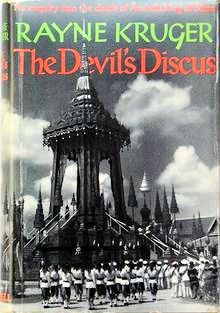
Abb.:
Umschlagtitel
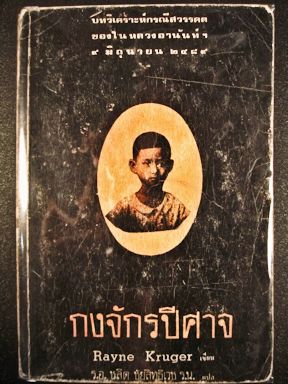
Abb.:
Einbandtitel
"The Devil's Discus is an investigation into the death of King Ananda Mahidol (Rama VIII) of Siam (later Thailand) by English-South African author Rayne Kruger (1922 - 2003).[1]
Book summaryThe book comprises four main sections which are each further divided into chapters. The section “Before” serves as an introduction to King Ananda’s death, to Siam and to King Ananda’s background.
The next section “The Life and Death of Ananda” is ten chapters in length and details the main events of King Ananda’s life, from his birth in Heidelberg in 1925 to his death by a single gunshot in mysterious circumstances at Bangkok’s Royal Palace on 9 June 1946. This section introduces the main characters surrounding Ananda throughout his life and who subsequently become subjects for investigation following his death.
“The Trial” is the fourth section of eight chapters that summarises the events and arguments of the subsequent regicide trial against three Palace officials. Including two appeals the trial lasted more than six years and resulted in the execution of all three defendants in 1955.
The final section “Who Killed Ananda ?” is Kruger’s own analysis of the evidence surrounding Ananda’s death leading him to the conclusion that the only satisfactory explanation is suicide. He supports this theory with the revelation of a love affair between the young King and a fellow law student in Switzerland, Marylene Ferrari, a relationship which would not have been acceptable to Siam’s Royalist institutions.
Publication historyThe Devil's Discus was first published in 1964 by Cassell. The Thai government banned the book as soon as it was published and Kruger was banned from further entry to Thailand.[2]
A Thai translation of the book titled Kongchak Pisat (Thai: กงจักรปีศาจ) by Chalit Chaisithiwet (Thai: ร.อ.ชลิต ชัยสิทธิเวช) was produced for submission as evidence in a 1970 defamation lawsuit brought by Pridi Banomyong (ปรีดี พนมยงค์, 1900 - 1983) against MR Kukrit Pramoj (คึกฤทธิ์ ปราโมช, 1911- 1995) and his newspaper Siam Rath (สยามรัฐ). The translator was the elder brother of Pridi's secretary, Vacharachai Chaisithiwet (วัชรชัย ชัยสิทธิเวช). It was secretly published by two Thammasat students in 1974 and reprinted in 1977, and circulated behind closed doors in Thailand. A local printing house involved with this Thai edition was burnt down.[3] This translation was eventually officially banned in May 2006.[4]
Through the organisation Freedom Against Censorship Thailand (FACT),[5] the English text was reprinted in November 2009 by DMP Publications, Hong Kong.
Critical DiscussionIn 2011 Andrew MacGregor Marshall published online #thaistory [6] in which he describes the genesis of The Devil's Discus; "Krueger wrote it on the suggestion of Prince Subhasvasti (หม่อมเจ้าศุภสวัสดิ์วงศ์สนิท สวัสดิวัตน์, 1900 - 1967), brother of Prajadhipok’s wife Queen Rambhai (รำไพพรรณี, 1904 - 1984)..... [Subhasvasti] came to trust and respect Pridi as a result of their wartime cooperation...... He believed – entirely correctly – that Pridi had nothing to do with Ananda’s death. The Devil’s Discus was envisaged as a way of rehabilitating Pridi’s reputation in the hope that he would be able to return from exile and play a leading role in Thai politics once again."
Marshall's view is that the most likely explanation of Ananda's death is that he was shot accidentally by his younger brother Bhumipol, hence he goes on to say "Krueger’s book, published in 1964 after extensive research and considerable assistance from Subhasvasti, did a very good job of demolishing the case against Pridi. But the problem was that an alternative explanation for Ananda’s death had to be provided. And to conclude that Bhumibol was responsible was, of course, totally unacceptable to the royalist establishment – the book was supposed to enable détente between Rama IX and Pridi, not to declare full-scale war. So Krueger had to find a way to discard the likeliest explanation – that Bhumibol shot his brother – and promote the only credible alternative conclusion, suicide.""
[Quelle: http://en.wikipedia.org/wiki/The_Devil%27s_Discus. -- Zugriff am 2013-02-14]
1964 - 1966
In Zeitungen erscheint der Fortsetzungsroman Rueang Khong Chan Dara (เรื่องของจัน ดารา; literally Account of Chan Dara) von Utsana Phloengtham (อุษณา เพลิงธรรม) (i. e. Pramun Unhathup - ประมูล อุณหธูป, 1920 - 1987)
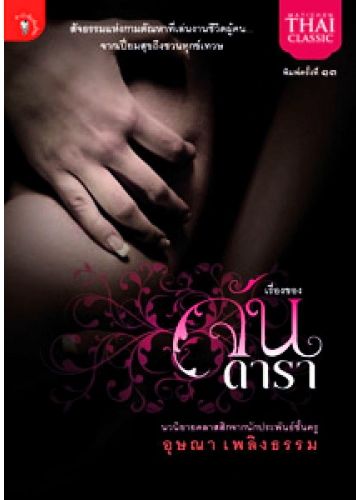
Abb.:
Einbandtitel einer Neuausgabe
Die Geschichte wird mehrmals verfilmt:
1997: Chan Dara (จัน ดารา) von Rat Setthaphakdi (รัตน์ เศรษฐภักดี)
2001: Chan Dara (จัน ดารา) von onzee Nimibutr (นนทรีย์ นิมิบุตร, 1962 - )
2012/2013: Chan Dara (จัน ดารา) in zwei Teilen von Bhandevanov Devakula (หม่อมหลวงพันธุ์เทวนพ เทวกุล, 1953 - )
1964
Der Musikmanger von TV Channel 4 Jamnong Rangsikun (จำนง รังสิกุล, 1913 - 1995) prägt den Begriff เพลงลูกทุ่ง (Phlaeng Luk Thung - "Lieder der Kinder des Felds") für die Musikgattung die bisher unter verschiedenen Begriiffen bekannt war wie
เพลงชาวบ้าน (Phlaeng chao ban - "Dörfler-Lieder")
เพลงชีวิต (Phlaeng chiwit - Lebens-Lieder")
เพลงตลาด (Phlaeng talat - Markt-Lieder)
"Influences on luk thung [ลูกทุ่ง] can be divided roughly into three categories— Thai, Western, and other Asian.
- The Thai influences include
- phleng Thai doem [เพลงไทยเดิม] and
- ramwong [รำวง];
- central Thai folk genres such as
- phleng lae [เพลงแหล่],
- isaeo [อีแซว],
- choi [ฉ่อย], and
- lamtat [ลำตัด];
- Isan
- molam [หมอลำ],
- soeng [เซิ้ง], and
- kantruem [กันตรึม];
- Northern
- phleng so [เพลงซอ ?]; and
- Southern
- nangtalung [หนังตะลุง] and
- manora [มโนราห์].
- Western and Latin American influences include
- nineteenth-century brass-band music,
- cha-cha,
- rock,
- disco,
- funk,
- jazz, and
- Latin pop.
- Other Asian sources include
- Bollywood [बॉलीवुड] film songs and
- Chinese Cantopop [粵語流行音樂]."
[Quelle: Mitchell, James Leonhard: Luk Thung : the culture and politics of Thailand's most popular music. -- Chiang Mai : Silkworm, 2015. --208 S. : Ill ; 21 cm. -- ISBN 978-616-215-106-4. -- S. 47]
1964
Benjamin (Tumthong Chokchana, 1921 - 2994) (เบญจมินทร์ (ตุ้มทอง โชคชนะ)) gründet die Band เบญจมินทร์และสหาย (Benjamin und Gefährten). Nach einem Jahr zieht sich Benjamin aus dem Musikbusiness zurück und übergibt die Leitung Kuson Kamonsing (กุศล กมลสิงห์)
Künstlerlink auf Spotify:
URI: spotify:artist:3UdkeS5ugWp1TFdUVvemty
URL: https://open.spotify.com/artist/3UdkeS5ugWp1TFdUVvemty
Abb.: Kuson Kamonsing (กุศล กมลสิงห์)
[Fair use]
1964
In Thailand gibt es 40 bis 50 Truppen für chinesische Opern Sie werden zunehmend von Filmen verdrängt.
1964

Briefmarken:
1964

Burma: Gründung der Shan State Army (SSA, กองทัพรัฐฉาน)
"Formation of Shan State Army By 1964, there were four major Shan State rebels groups:
- Noom Suk Harn: established in 1958, as the first Shan resistance organisation.
- Shan State Independence Army (SSIA): established in 1961.
- Shan National United Front (SNUF): established jointly with SSIA.
- Tailand National Army (TNA): established in 1963 by a faction which broke away from SSIA.
Following the arrest of Sao Shwe Thaik (စဝ်ရွှေသိုက်, 1894 - 1962) of Yawnghwe in the Burmese coup d'état in March 1962 by the Revolutionary Council headed by General Ne Win, his wife, Sao Nang Hearn Kham (Mahadevi of Yawnghwe) (1916 - 2003) fled with her family to Thailand in April 1962. Sao Shwe Thaik died in prison in November the same year and while in exile his wife participated in the independence struggle of the Shan State.In 1964, Sao Nang Hearn Kham became the leader of SSIA, and tried to unify the four rebel factions. However, she could not make Noom Suk Harn and TNA to agree for unification, therefore, SNUF merged with SSIA and formed Shan State Army (SSA).[2]:18 The formation took place at the headquarters of SSIA in the mountains near the Thai border. It aimed to expand its forces to a state-wide organisation by incorporating other rebel groups.[3]:220
Since its formation, SSA had attracted widespread intellectual and rural support.[3]:333 In 1961, there were no more than 1,500 Shan rebels in total, which by 1987 grew to 7,000 to 9,000. The battles were so fierce that in 1978, 20 to 30 casualties suffered daily in Shan State alone.[2]:59 SSA eventually established four large base areas across Shan state, north to south and on the west to the bank of Salween River."
[Quelle: http://en.wikipedia.org/wiki/Shan_State_Army. -- Zugriff am 2014-11-10]
1964


Als Beitrag zur Finanzierung des Vietnamkriegs verpflichtet sich die Bundesrepublik Deutschland (Bundeskanzler ist Ludwig Erhart), in den USA bis 1967-06-30 für die Bundeswehr Waffen und Material im Wert von 1,35 Milliarden US$ zu kaufen.
Abb.: Ludwig Erhart
[Bildquelle: Plakat- und Filmarchiv der CDU. -- Creative Commons Lizenz (Namensnennung, share alike)]
1964

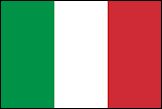
Premiere des französisch-italienischen Action-Films "Banco à Bangkok pour OSS 117" von André Hunebelle (1896–1985)
1964

Es erscheint:
Babst, Dean Voris <1921 - 2006>: Elective Governments : a force for peace. The Wisconsin Sociologist 3 (1, 1964): 9–14
Darin behauptet der US-Soziologe Bapst die Democratic peace theory, die "Hypothese, dass Kriege zwischen demokratischen Staaten nicht (bzw. statistisch signifikant seltener als zwischen nichtdemokratischen oder gemischten Staatenpaaren) stattfinden." (Wikipedia). Diese Theorie spielt in der Außenpolitik der USA eine wichtige Rolle.
"And the reason why I'm so strong on democracy is democracies don't go to war with each other. And the reason why is the people of most societies don't like war, and they understand what war means.... I've got great faith in democracies to promote peace. And that's why I'm such a strong believer that the way forward in the Middle East, the broader Middle East, is to promote democracy." US-Präsident George W. Bush, 2004-11-12
1964-01-05


Thailand nimmt Angebot Australiens an, in Zusammenarbeit mit den britischen Streitkräften in Nordostthailand einen Flugplatz zu bauen.
1964-01-06
Chin Sophonpanich (Thai: ชิน โสภณพนิช, Chinese: 陳弼臣, 1910 - 1988), der Gründer der Bangkok Bank (ธนาคารกรุงเทพ), kehrt aus seinem Exil in Hongkong (香港,) zurück. Er war fünf Jahre zuvor von Diktator Sarit Thanarat (สฤษดิ์ ธนะรัชต์, 1908 - 1963) ins Exil getrieben worden. Chin gibt in der Folge dem stellvertretenden Ministerpräsidenten Praphat Charusathien (ประภาส จารุเสถียร, 1912 - 1997) den Posten des Vorsitzenden des Vorstands der Bangkok Bank.
1964-01-07

Memorandum From the Secretary of Defense (Robert S. McNamara, 1916 - 2009) to the President, Lyndon Baines Johnson (1908 – 1973):
"4. The consequences of a Communist-dominated South Vietnam are extremely serious both for the rest of Southeast Asia and for the U.S. position in the rest of Asia and indeed in other key areas of the world. a. In Southeast Asia, Laos would almost certainly come under North Vietnamese domination, Cambodia might exhibit a facade of neutrality but would in fact accept Communist Chinese domination Thailand would become very shaky, and Malaysia, already beset by Indonesia, the same; even Burma would see the developments as a clear sign that the whole of the area now had to accommodate completely to Communism (with serious consequences for the security of India as well).
Basically, a truly “neutral” Southeast Asia is very unlikely to emerge from such a sequence of events, even if the U.S. itself tried to hold a firm position in Thailand, if Malaysia too tried to stand firm and even if such remote and uninvolved powers as France backed the concept of “neutrality.”
b. In the eyes of the rest of Asia and of key areas threatened by Communism in other areas as well, South Vietnam is both a test of U.S. firmness and specifically a test of U.S. capacity to deal with “wars of national liberation.” Within Asia, there is evidence—for example, from Japan—that U.S. disengagement and the acceptance of Communist domination would have a serious effect on confidence. More broadly, there can be little doubt that any country threatened in the future by Communist subversion would have reason to doubt whether we would really see the thing through. This would apply even in such theoretically remote areas as Latin America."
[Quelle: https://history.state.gov/historicaldocuments/frus1964-68v01/d8. -- Zugriff am 2016-07-01]
1964-01-15
Die Polizei versucht, in Bangkok die Vorschriften über höchste Schadstoffemissionen von Fahrzeugen durchzusetzen. Die Schadstoffwerte der Luft liegen weit über 100 ppm CO. Im Mittel gelten Belastungen von mehr als 100 ppm als gesundheitsgefährdend.
1964-01-23

Robert Francis "Bobby" Kennedy (1925 – 1968) nutzt einen Zwischenhalt in Bangkok zu Gesprächen mit dem Thai Außenminister und dem malaysischen Verteidigungsminister.
Abb.: Robert Francis "Bobby" Kennedy, 1964
[Bildquelle: LBJ Library photo by Yoichi R. Okamoto / Wikipedia. -- Public domain]
1964-01-24
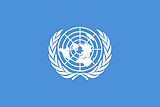
Eröffnung des von der UNO finanzierten Asian Institute for Economic Development and Planning (AIEDP) in Bangkok.
1964-01-27


Frankreich nimmt mit Rotchina (Volksrepublik China) diplomatische Beziehungen auf.
1964-01-30
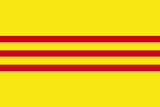
Militärputsch in Südvietnam. Die nur 3 Monate amtierende vorherige Putschregierung habe mit den Neutralisierungsplänen für Südvietnam des französischen Staatspräsidenten Charles de Gaulle sympathisiert. Die USA erklärt der neuen Regierung ihre volle Unterstützung, da diese versichert habe, mit Hilfe der USA den Kampf gegen den Vietcong unvermindert weiterzuführen.
1964-02/03
Die Lawa (ละว้า / ลั๊วะ / ລະວ້າ) werden aufgefordert, sich in Mae Sariang (แม่สะเรียง) zu melden, um photographiert zu werden und einen Personalausweis zu erhalten. Dafür sollen sie eine Gebühr bezahlen. Die Lawa betrachten das als Steuer und es erscheint kein einziger Lawa.
Abb.: Lebensräume der Lawa (ละว้า / ລະວ້າ) um Mae Sariang (แม่สะเรียง)
[Bildquelel: Minority groups in Thailand / Joann L. Schrock [u. a.]. -- Washington: Headquarters, Dept. of the Army, 1970. -- 1135 S. : Ill. ; 24 cm. -- (Ethnographic study series) (Department of the Army pamphlet ; no. 550-107). -- S. 936]
1964-02-03 - 1964-02-10

Boudewijn Albert Karel Leopold Axel Marie Gustaaf van België = Baudouin Albert Charles Léopold Axel Marie Gustave de Belgique (1930 - 1993) kommt auf Staatsbesuch nach Thailand.
Abb.: Lage von Belgien
[Bildquelle: OpenStreetMap. -- Creative Commons Lizenz (Namensnennung, share alike)]
Abb.: Boudewijn Albert Karel Leopold Axel Marie Gustaaf van België = Baudouin Albert Charles Léopold Axel Marie Gustave de Belgique (1930 - 1993) mit Gattin Fabiola Fernanda María de las Victorias Antonia Adelaida de Mora y Aragón (1928 - ), 1969
[Bildquelle: Schumacher, Karl H. / Wikipedia. -- Public domain]
1964-02-06 - 1964-03-04

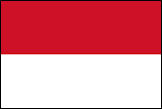

Bangkok: Waffenstillstandsverhandlungen zwischen Malaysia, Indonesien und den Philippinen wegen des bewaffneten Konflikts in Nordborneo. Die Verhandlungen werden ergebnislos abgebrochen, da Indonesien sich weigert, seine Truppen von malaysischem gebiet zurückzuziehen.
Abb.: Borneo in Kolonialzeit
[Bildquelle: Bartholomew, J. G. <1860 - 1920>: A literary & historical atlas of Asia. -- London, o. J.]
1964-02-07 - 1964-02-22


Erste Tournee der Beatles in den USA ein. Sie begeistern über 70 Mio. Amerikaner.
Abb.: Ankunft der Beatles in New York, 1964-02-07
[Bildquelle: United Press International, photographer unknown / LoC / Wikipedia. -- Public domain]
1964-02-10

Toyota, der größte Automobilproduzent Asiens, eröffnet in Samut Prakan (สมุทรปราการ) eine Montagefabrik. Dort können pro Monat bis zu 300 Personen- und Lastwagen montiert werden.
Abb.: Lage von Samut Prakan (สมุทรปราการ)
[Bildquelle: OpenStreetMap. -- Creative Commons Lizenz (Namensnennung, share alike)]
Abb.: Toyota-Feuerwehrauto, bei Chiang Mai (เชียงใหม่), 2005
[Bildquelle: Mr.bloom / Wikimedia. -- GNU FDLicense]S
1964-02-19
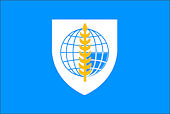
Konthi Suphamongkhon (กนต์ธีร์ ศุภมงคล, 1916 - ) wird Generalsekretär der SEATO.
"Konthi Suphamongkhon (Thai: ดร. กนต์ธีร์ ศุภมงคล, * 3. August 1916) ist ein ehemaliger thailändischer Diplomat. Biografie
Konthi Suphamongkhon war als Diplomat im thailändischen Außenministerium tätig und zeitweise Leiter der dortigen Westabteilung.[1] Danach war er zwischen 1956 und 1959 als Botschafter in Australien sowie in Neuseeland akkreditiert.
Nach einer erneuten Verwendung im Außenministerium wurde er am 19. Februar 1964 Generalsekretär der SEATO und übte dieses Amt bis zum 1. Juli 1965 aus.
Im Anschluss wurde Prof. Dr.[2] Konthi Suphamongkhon zum Botschafter in der Bundesrepublik Deutschland ernannt und verblieb auf diesem Posten bis 1970. Zugleich war er zwischen 1967 und 1970 als Botschafter in Finnland akkreditiert. Zuletzt war er von 1970 bis zu seinem Eintritt in den Ruhestand 1976 Botschafter im Vereinigten Königreich.
Sein Sohn Kantathi Suphamongkhon (กันตธีร์ ศุภมงคล, 1952 - ) wurde ebenfalls Diplomat und war zwischen 2005 und 2006 Außenminister.[3]"
[Quelle: http://de.wikipedia.org/wiki/Konthi_Suphamongkhon. -- Zugriff am 2012-03-20]
1964-02-24 - 1964-03-03

Al-Marhum Tuanku Syed Putra Ibni Al-Marhum Syed Hassan Jamalullail (1920 - 2000), Raja von Perlis, Yang di-Pertuan Agong (König) von Malaysia mit Gattin Duli Yang Maha Mulia Almarhumah Tengku Budriah binti Almarhum Tengku Ismail (1924 - 2008) kommt auf Staatsbesuch.
Abb.: Malaysia mit Perlis
[Bildquelle: CIA. -- Public domain]
Abb.: Al-Marhum Tuanku Syed Putra Ibni Al-Marhum Syed Hassan Jamalullail
[Bildquelle: ms.Wikipedia. -- Fair use]
Abb.: Duli Yang Maha Mulia Almarhumah Tengku Budriah binti Almarhum Tengku Ismail
[Bildquelle: ms.Wikipedia. -- Fair use]
1964-02-29

Australien: Stapellauf der M. V. Kooringa, "des weltweit erste Zellencontainerschiffs, ("custom-designed cellular container ship to handle 20-ton containers") das als solches geplant und erbaut wurde". (Wikipedia). Das Zeitalter der Containerschiffe beginnt.
Abb.: Inserat, 1967-10
[Fair use]
Abb.: Containerhafen Bangkok, 2008
[Bildquelle: Prachanart Viriyaraks. -- http://www.flickr.com/photos/33437095@N08/9684932225. -- Zugriff am 2013-10-11. -- Creative Commons Lizenz (Namensnennung)]
1964-03


Die USA schicken eine Airforce Special Warfare unit nach Thailand, um laotische und Thai Piloten für Einsätze über Laos auszubilden. Bald darauf werden Laotisch sprechende Thai-Piloten mit Ausweisen der laotischen Luftwaffe mit North American Aviation T-28 Trojan Bodenangriffsflugzeuge zu Angreiffen auf laotische Aufständische geschickt.
1964-03

Eröffnung des Bangkok Liaison Office of the Center for Southeast Asians Studies (CSEAS, 京都市左京区吉田下阿達町) der japanischen Kyoto University (京都大学). Das CSEAS war 1963 gegründet worden.
1964-03-01
Das Innenministerium plant, in 22 Provinzen die zweimalige Reisernte pro Jahr zu fördern. Insgesamt sind 300.000 rai (ไร่, 48.000 km²) Land für zweimalige Reisernte vorgesehen, für 1964 allerdings nur 50.000 rai (8000 km²)
1964-03-17

Nach 21 Tagen Staatstrauer und 100 Tagen Aufbahrung wird der Leichnam von Ministerpräsident Sarit Thanarat (สฤษดิ์ ธนะรัชต์, 1908 - 1963) feierlich kremiert. Die pompöse staatliche Feier steht unter der Obhut von König Bhumibol und Gattin. Es kommt zu kleineren Zwischenfällen mit einigen von Sarits über 100 Nebenfrauen (เมียน้อย, Mie Noy).
Abb.: Sarit Thanarat - สฤษดิ์ ธนะรัชต์
[Bildquelle: Wikimedia. -- Public domain]
1964-03-25

Chiang Mai: Repräsentanten verschiedener Shan-Aufständischen-Gruppen gründen die Shan State Army (SSA, ရှမ်းပြည် တပ်မတော်). Oberste Führerin ist die Yawnghwe Mahadevi (Sao Nang Hearn Kham, Daw Hearn Kham (မဟာဒေဝီစောဝ် နန်းဟိန်ခမ်, 1916 - 2003).
Abb.: Sao Nang Hearn Kham, Daw Hearn Kham (မဟာဒေဝီစောဝ် နန်းဟိန်ခမ), 1947
"Process By 1964, there were four major Shan State rebels groups:
- Noom Suk Harn: established in 1958, as the first Shan resistance organisation.
- Shan State Independence Army (SSIA): established in 1961.
- Shan National United Front (SNUF): established jointly with SSIA.
- Tailand National Army (TNA): established in 1963 by a faction which broke away from SSIA.
Following the arrest of Sao Shwe Thaik (စဝ်ရွှေသိုက်, 1894 - 1962) of Yawnghwe (ယွင်ႈႁူၺ်ႈ) in the Burmese coup d'état in March 1962 by the Revolutionary Council headed by General Ne Win,[4] his wife, Sao Nang Hearn Kham (မဟာဒေဝီစောဝ် နန်းဟိန်ခမ်, 1916 - 2003), (Mahadevi of Yawnghwe) fled with her family to Thailand in April 1962. Sao Shwe Thaik died in prison in November the same year and while in exile his wife participated in the independence struggle of the Shan State.In 1964, Sao Nang Hearn Kham became the leader of SSIA, and tried to unify the four rebel factions. However, she could not make Noom Suk Harn and TNA to agree for unification, therefore, SNUF merged with SSIA and formed Shan State Army (SSA).[3]:18 The formation took place at the headquarters of SSIA in the mountains near the Thai border. It aimed to expand its forces to a statewide organisation by incorporating other rebel groups.[5]:220
Since its formation, SSA had attracted widespread intellectual and rural support.[5]:333 In 1961, there were no more than 1,500 Shan rebels in total, which by 1987 grew to 7,000 to 9,000. The battles were so fierce that in 1978, 20 to 30 casualties suffered daily in Shan State alone.[3]:59 SSA eventually established four large base areas across Shan state, north to south and on the west to the bank of Salween River.[5]:333
OrganisationThe highest organ of SSA was the Shan State War Council (SSWC), which composed of:
- Chairperson: Mahadevi of Yawnghwe
- Vice chairperson and Chief of staff: Moherng of Laikha and Muang Kung area (Former commander of Noom Suk Harn and broke away to form SNUF)
- Vice chief of staff: Sai Pan, Khun Thawa and Jimmy Yang (or Chao Ladd, who joined in 1966)
- Other member: Sai Myint Aung
As combats, local Shan people were recruited. A leadership school was set up in 1969 and taught basic geography and history, basic government, the fundamentals of military organisation and operations, intelligence gathering and reporting, political system and theories, and an introduction of international politics.[3]:132–4
In 1971, its political wing, Shan State Progress Party (SSPP) was formed to tackle various problems SSA faced.[5] Shan Unity Preparatory Committee (SUPC) was also formed to unite other Shan rebel groups. It planned to merge SSA with SSA/East, which TNA renamed itself, and Shan National Independence Army (SNIA), which Noom Suk Harn renamed itself. However, it did not work out, as SNIA collapsed which its leader set up a new organisation to fight against communism.
[...]
DissolutionAs the struggle became fierce in the Shan State, SSA units in the north approached CBP for support, which CBP responded with military training and arms provision. On the other hand, the SSA in southern Shan opposed to the alliance with CBP (Communist Party of Burma, ဗမာပြည်ကွန်မြူနစ်ပါတီ), therefore, led to an internal split in SSA- the north and the south.[8] There were further internal divisions, such as in 1966 two units breaking away and setting up their own nationalist front,[5] and external pressures for not being able to unite Shan rebels as more fights intensified with the Burma Army, CBP, other rebels and drug trade. As a result, SSA collapsed in the mid-1976. About 4,000 soldiers switched loyalty to the CPB and others joined other rebel forces.[3] Later, SSPP reformed a pro-communist army known as Shan State Army-North (SSA-N, ရှမ်းပြည်တပ်မတော် - မြောက်ပိုင်း) and continued its fight, until the fall of CBP in 1989, when it signed the ceasefire agreement with the Burmese government.[9][10] In opposition to ceasefire, a faction that broke away formed Shan State Army-South (SSA-S, တပ်ႉသိုၵ်းၸိုင်ႈတႆး - ပွတ်းၸၢၼ်း), or Restoration Council of Shan State/ Shan State Army in 1996. However, in 2011 SSA-S signed a ceasefire agreement with the Burmese government.[11] Although the Burmese government accomplished in signing ceasefire with two of the largest armed rebel forces in the Shan State, there still has been reports of clashes. According to the Shan Human Rights Foundation, in October 2014, shells were fired in villages of Shan State, which caused over 180 villagers to evacuate.[12] Between 1996 and 2001, there has been reports of 173 sexual assaults in Shan state by Burmese troops and between 1996 and 1998, 300,000 villagers had relocated."
[Quelle: https://en.wikipedia.org/wiki/Shan_State_Army. -- Zugriff am 2016-05-09]
1964-03-28
Es erscheint die erste Ausgabe der Tageszeitung เดลินิวส์ (Daily News). Herausgeber ist Saeng Hetrakul (แสง เหตระกูล)
Abb.: Titelblatt einer Ausgabe 2012
1964-04-02

Unterzeichnung des Thai-Deutschen Abkommens über technische Zusammenarbeit.
1964-04-03


Die Sowjetunion reagiert in einer Rede ihres Chefideologen Michail A. Suslow (Михаил Андреевич Суслов, 1902 - 1982) in aller Schärfe auf die zahlreichen verbalen Angriffe der Volksrepublik China auf die Sowjetunion in den letzten sechs Monaten.
1964-04-06 - 1964-04-11

Zweiter Nationalkongress der kommunistischen Neo Lao Haksat (ແນວລາວຮັກຊາຕ = Pathet Lao - ປະເທດລາວ) in der laotischen Provinz Sam Neua (ຊຳເຫນືອ) beschließt folgendes Aktionsprogramm:
"Action Program of the Neo Lao Hak Sat
- To unite all the people, unite various nationalities [tribal groups], strata, religious communities, political parties, patriotic personalities, and intellectuals, including individuals in the Royal Family and Buddhist monks and nuns who favor peace and neutrality, regardless of their political tendencies, beliefs and religion, also organizations and individuals who were formerly forced by the United States to follow it but now favor a policy of peace and neutrality; and to strive to consolidate and strengthen the alliance and mutual assistance between the Neo Lao Hak Sat and the patriotic Neutralist forces.
- To struggle against the United States imperialists and their followers—the traitors—for a correct implementation of the 1962 Geneva agreements and the agreements reached among the three parties of Laos; to defend and consolidate the coalition government so as to fully carry out the political program aimed at restoring peace, building national concord, and consolidating the independence of the country; first of all to demand that the United States imperialists and their satellites withdraw all their troops from Laos, stop the introduction of weapons and war material into Laos and all acts of intervention in Lao affairs under whatever form and in whatever fields, and not set up military bases on Lao territory; to demand that the Phoumi Nosavan [ຜກຸມກິ ນອວກະກະສນ, 1920 - 1985] group put an end to aiding operations encroaching upon and terrorizing the people and withdraw their troops to the positions existing when the 1962 Geneva agreements were signed; to demand that the Phoumi Nosavan group strictly implement the agreements concluded among the three parties: first of all to organize the mixed police and to neutralize Vientiane [ວຽງຈັນ] and Luang Prabang [ຫລວງພະບາງ] so as to restore the normal activities of the coalition government, and then to continue the tripartite negotiations in order to settle pending questions and other problems of the fatherland and people.
- To correctly carry out the policy of peace and neutrality ensured by the Geneva agreements, implement the independent foreign policy on the basis of the Five Principles of Peaceful Coexistence, to establish diplomatic relations with all countries on an equal footing, receive aid without any conditions attached from all countries regardless of their political regimes, provided the latter respect the sovereignty and independence of Laos and sincerely help Laos’ national construction; to actively support all movements for peace, democracy, and social progress, and the national liberation movement of all the Asian, African, and Latin American countries, and actively contribute to the safeguarding of peace in Southeast Asia and the world.
- To heighten the spirit of self-reliance and at the same time make full use of assistance without any conditions attached from various countries to build an independent and self-supporting economy under the leadership and unified management of the coalition government; to. wipe out the vestige of local despots and trade monopolies, and at the same time to help people develop production, tap forest products and natural resources, expand exchanges of goods, develop handicrafts, and build industry; to eliminate speculation and hoarding, oppose corruption and misuse of power to grab goods and economic monopolies; to help the peasants develop cultivation and livestock breeding; to encourage the improvement of cultivation and protection of crops, thus helping the peasants to raise their income; to help the workers to get jobs, to improve their living conditions, and create a regime of social insurance so as to enable them to restore and develop the national economy; to stimulate and help the traders and industrialists to invest in construction and commerce which benefit the national economy and the people’s life; to create conditions for students and pupils to study and develop their abilities to serve the fatherland; to provide intellectuals, office employees, cultural workers, and artists with suitable jobs and security so that they may serve the people.
- To organize and build a national army and police force to defend the independence of the fatherland and the security of the people; to help soldiers and policemen to come close to and help the people; to forbid all repression of the people by the army and the police; to ensure political rights and due pay for soldiers; to cancel the regime of ill treatment of soldiers and policemen; to work out a policy to improve the living conditions of wounded soldiers’ and war martyrs’ families.
- To carry out all the democratic rights of the citizens as provided for by the 1947 Constitution, thus enabling them to devote all their abilities to serve national construction; first of all to release all political detainees and ensure the life and property of the people; to stop all acts of discrimination and reprisal against patriotic individuals and organizations in the areas temporarily controlled by the Phoumi Nosavan group, especially Vientiane.
- To respect and defend the Throne, build and consolidate national solidarity, and realize national harmony and unification; to carry out the policy of national union, thus helping the various nationalities [tribal groups] to live on an equal footing and carry out mutual assistance, improving their living standards, helping each other in studying; to oppose all schemes of sowing discord among the nationalities [tribal groups] and ensure the legitimate rights of foreign residents in Laos.
- To assure equality between men and women; help women in all fields so as to enable them to develop their ability to catch up with men; to help confined mothers and protect children.
- To develop progressive national culture; to devote attention to education and develop both primary and secondary educational systems and other popular educational schools; to help all the people, especially the mountain people, to learn to read and write; to protect and develop good ethics; to strictly oppose the depraved and obscurantist culture of the United States and its henchmen; to eliminate gambling and other social vices; to respect freedom of belief, oppose all schemes to sabotage and split up religions; to protect pagodas and respect Buddhist priests.
- While the United States imperialists have not yet given up their schemes to eliminate the Neo Lao Hak Sat and other patriotic forces, to turn Laos into a neocolony, a war-provocative base, and to turn the Lao people into their slaves, all the people of Laos have the task of defending and consolidating the liberated areas, strengthening the Neo Lao Hak Sat forces, helping to consolidate the other patriotic forces, resolutely smashing all schemes to encroach upon and occupy the liberated areas and to send bandits to disturb and sabotage these areas. The people of Laos must actively carry out all tasks which benefit the people and must bring them a happy life so as to help them build the liberated areas into a firm basis for the people’s struggle for peace, neutrality, independence, democracy, unity, and prosperity."
[Zitiert in: Dommen, Arthur J. <1934 - 2005>: Conflict in Laos : the politics of neutralization. -- New York : Praeger, 1964. -- 338 S. ; 22 cm. -- S. 319 - 321]
1964-04-10
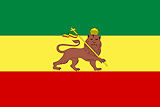
Aufnahme diplomatischer Beziehungen mit Äthiopien.
Abb.: Lage von Äthiopien
[Bildquelle: OpenStreetMap. -- Creative Commons Lizenz (Namensnennung, share alike)]
1964-04-15

Prinzessin Shams ul-Mulk Pahlavi (شمس پهلوی) (1917 - 1996), Schwester des Shahs von Iran und ihr Gatte, Mehrad Pahlbod (مهرداد پهلبد) sind fünf Tage auf Besuch in Thailand.
Abb.: Lage von Iran
[Bildquelle: OpenStreetMap. -- Creative Commons Lizenz (Namensnennung, share alike)]
Abb.: Prinzessin Shams ul-Mulk Pahlavi (شمس پهلوی)
[Bildquelle: fa.Wikipedia. -- Public domain]
1964-04-16

Es erscheint "The Rolling Stones", die erste LP der 1962 gegründeten britischen Rockband "The Rolling Stones".
Abb.: Plattentitel
[Bildquelle: Wikipedia. -- Fair use]Das Album auf Spotify:
URI: spotify:album:7Kln3VdaLUYVIFpqe7AuNA
URL: https://open.spotify.com/album/7Kln3VdaLUYVIFpqe7AuNA
1964-04-20 - 1964-04-30

SEATO Luftwaffen-Übung AIR BOON CHOO in Thailand.
1964-04-22 - 1964-10-18; 1965-04-21 - 1965-10-17

1964/1965 New York World's Fair. Der Thailändische Pavillon findet viel Beachtung.
Abb.: Lage von New york
[Bildquelle: OpenStreetMap. -- Creative Commons Lizenz (Namensnennung, share alike)]
Abb.: Thailands Pavillon auf 1964/1965 New York World's Fair
[Bildquelle: Postkarte. -- Fair use]
1964-04-25

Vermutlich erste Deklaration des US Antidraft Movement:
"WE THE UNDERSIGNED, ARE YOUNG AMERICANS OF DRAFT AGE. We understand our obligations to defend our country and to serve in the armed forces but we object to being asked to support the war in South Vietnam.
Believing that United States' participation in the war is for the suppression of the Vietnamese struggle for national independence, we see no justification for our involvement. We agree with Senator Wayne Morse, who said on the floor of the Senate on March 4, 1964, regarding South Vietnam, that "We should never have gone in. We should never have stayed in. We should get out."
BELIEVING THAT WE SHOULD NOT BE ASKED TO FIGHT AGAINST THE PEOPLE OF VIETNAM, WE HEREWITH STATE OUR REFUSAL TO DO SO."
[Zitiert in: Vietnam and America : a documented history / [edited] by Marvin E. Gettleman [and others]. -- rev. and enlarged 2. ed. -- New York : Grove Press, 1995. -- 560 S. ; 25 cm. -- ISBN 0-8021-3362-2. -- S. 301. -- Fair use]
Abb.: Freedom Draft Card, 1965
[Bildquelle: Vietnam and America : a documented history / [edited] by Marvin E. Gettleman [and others]. -- rev. and enlarged 2. ed. -- New York : Grove Press, 1995. -- 560 S. ; 25 cm. -- ISBN 0-8021-3362-2. -- S. 302. -- Fair use]
1964-05-12

Beginn des von den USA unterstützten Accelerated Rural Development (ARD) Programme für 6 besonders durch den Kommunismus gefährdete Provinzen Nordostthailands:
Nakhon Phanom (นครพนม),
Loei (เลย),
Nong Khai (หนองคาย),
Sakon Nakhon (สกลนคร),
Udon (อุดรธานี),
Ubon (อุบลราชธานี).
1965 kommen hinzu die Provinzen:
Chiang Rai (เชียงราย),
Nan (น่าน),
Uttaradit (อุตรดิตถ์),
Roi Et (ร้อยเอ็ด),
Kalasin (กาฬสินธุ์).
Abb.: Provinzen unter dem Accelerated Rural Development (ARD) Programme, 1965
[Bildquelle: CIA. -- Public domain]
"History
The Accelerated Rural Development (ARD) Program was officially launched on May 12, 1964 with the signing of the FY 64 Project Agreements between the Royal Thai Government (RTG) and the USAID Mission (USOM) to Thailand. These "Pro Ags" granted $2. 3 million to the Thai Government, for use in six northeastern provinces. The stated objectives of the program were to increase the income of the rural population, to improve ties between the Royal Thai Government and rural people, and to strengthen local self-government. The general strategy for achieving these objectives was to decentralize many-of the developmental activities then being carried out by central government agencies, and place them under the control of the provincial governor. To assist the governor in this new role, equipment and advice from USOM, and personnel and funds from the central government, would be provided.Initially, the program focused almost entirely on the construction of feeder roads because other planned ARD activities depended on these roads to reach the rural populace. To quote a former USOM Director, the initial strategy was "to develop a plan of decentralization with an organizational structure, staff, and budget at the provincial level in these six provinces, furnishing governors of these provinces various pieces of road construction equipment, such as bulldozers, dump trucks, and the like. We had a basis then for formulating small public works units at the provincial level that would not be unlike the county units in the United States. Certainly, if rural people had to wait for the central ministries to go and do everything for them, we couldn't expect quick responses.""
[Quelle: http://pdf.usaid.gov/pdf_docs/Pdacr645.pdf#page=4&zoom=auto,-155,711. -- Zugriff am 2014-11-20]
Die USA nennen Ziel und Zweck ndes Programms:
- "Increase income for rural people;
- Strengthen ties between the Thai government and the people; and
- Strengthen local self-government"
"The methods of accomplishing this have been through equipping and training a changwat [จังหวัด] administrative organization to plan, design, construct and maintain rural roads, village water facilities and other local public works in selected changwats and to coordinate the planning and implementation of various other local level developments. Changwats have been selected for ARD support on the basis of economic need and threat of insurgency. Therefore a basic underlying rationale for the ARD program has been to provide support for the government’s counterinsurgency efforts."
[Zitiert in: Randolph, R. Sean: The United States and Thailand : alliance dynamics, 1950-1985. -- Berkeley : Institute of East Asian Studies, University of California, 1986. -- 245 S. ; 23 cm. -- (Research papers and policy studies, 12). -- ISBN 0-912966-92-0. -- S. 102]
Bis 1970 baut ARD
- 2452 km Allwetter-Straßen
- 1469 km Nebenstraßen
- 125 Dämme
- 244 Teiche
- 1336 Brunnen
Trotzdem fehlen 1977 noch 19.000 km Straßen bis jedes Dorf Verbindung zu einer Allwetterstraße hat.
Die USA schenken den Provinzen Straßenbaumaschinen (Traktoren, Planierraupen, Lastwagen) im Wert von durchschnittlich $ 1,2 Mio. pro Provinz
Bis 1970 zahlen die USA $ 54,6 Mio. für das ARD-Progamm.
Obwohl das ARD-Programm der Dezentralisierung dienen soll, sind 1973 2380 von 6300 beim ARD Beschäftigte in Bangkok stationiert. Nur 13% der von den USA ausgebildeten Thais gehen in den ländlichen Raum. Dezentralisation scheitert.
Eine Evaluation des ARD 1970 ergibt:
"It was found, for example, that within two years of the construction of an ARD road the following pattern of events tended to occur along its route:
- vehicular movement increased from an average of one vehicle per hour during daylight in the dry season to 12-18 per hour;
- commercial and industrially-related traffic expanded rapidly;
- annual land and business tax revenues for the changwat moved upward by an average of 1,000 baht per kilometer constructed;
- government services flowing along the road increased substantially:
- post and telegraph business expanded between 300 and 1,000 percent;
- movement of "line agency" technicians increased by at least 200 percent;
- creation of new schools, midwifery centers, and other health care centers doubled and tripled in volume;
- and police patrolling and security-related actions expanded by over 500 percent."
[Quelle: Randolph, R. Sean: The United States and Thailand : alliance dynamics, 1950-1985. -- Berkeley : Institute of East Asian Studies, University of California, 1986. -- 245 S. ; 23 cm. -- (Research papers and policy studies, 12). -- ISBN 0-912966-92-0. -- S. 104]
1964-05-16

Der Pathet Lao (ປະເທດລາວ) startete einen Großangriff und erobert die Ebene der Tonkrüge (ທົ່ງໄຫຫິນ).
Abb.: Lage der Ebene der Tonkrüge (ທົ່ງໄຫຫິນ)
[Bildquelle: CIA. -- Public domain]
1964-05-17
Der König eröffnet den Yanhee-Damm (heute: Bhumibol-Damm - เขื่อนภูมิพล). Baukosten: 2.257.000 Baht. Kapazität: 560.000 Kw.
Dank des zusätzlichen Stroms werden die Strompreise in Bangkok um 8% gesenkt.
Abb.: Lage des Yanhee-Damms (heute: Bhumibol-Damm - เขื่อนภูมิพล)
[Bildquelle: OpenStreetMap. -- Creative Commons Lizenz (Namensnennung, share alike)]
Abb.: Elektrizitätserzeugung in Mio. Kilowattstunden 1934 - 1975
[Datenquelle: Mitchell (1982), S. 367]
Abb.: Bhumibol-Damm - เขื่อนภูมิพล, ca. 1967
Abb.: Bhumibol-Damm - เขื่อนภูมิพล
[Bildquelle: Love Krittaya / Wikimedia. -- Public domain]
"Die Bhumibol-Talsperre (Thai: เขื่อนภูมิพล) im Landkreis (Amphoe) Sam Ngao (สามเงา) der Provinz Tak (ตาก) in Nordthailand wurde von 1953 bis 1964 erbaut. Die Einweihung war im Mai 1964. Die 154 m hohe und 486 m lange Staumauer ist eine der größten in Südostasien. Die Talsperre ist nach König Bhumibol Adulyadej benannt und hieß vorher Yanhee-Talsperre. Eine Quelle gibt die Höhe der Staumauer über der Gründung sogar mit 245 Metern an. Das Absperrbauwerk, eine gekrümmte Gewichtsstaumauer, ist das zweithöchste in Thailand nach dem Königin-Sirikit-Staudamm (เขื่อนสิริกิติ์).
Die Staumauer staut den Maenam Ping (แม่น้ำปิง), einen Zufluss des Chao Phraya (แม่น้ำเจ้าพระยา), zu einem 12.200 Millionen Kubikmeter fassenden Stausee, dem Mae Ping Lake, auf. Der Stausee ist Teil des Mae-Ping-Nationalparks (อุทยานแห่งชาติแม่ปิง). Er ist – gemessen an der Fläche – der größte Stausee Thailands und der zweitgrößte nach dem Speicherinhalt.
Das Wasserkraftwerk an der Staumauer erzeugt elektrischen Strom mit einer Leistung von 535 MW vor allem für den Großraum Bangkok. Eine andere Quelle gibt 737,5 MW an. Außerdem dient die Talsperre der Wasserregulierung der Flüsse Ping und Chao Phraya und der Freizeiterholung. Von der Staumauer aus kann man mit einem Schiff 140 Kilometer stromaufwärts bis nach Chiang Mai fahren."
[Quelle: http://de.wikipedia.org/wiki/Bhumibol-Talsperre. -- Zugriff am 2011-11-10]
1964-05-23/25

Henry Cabot Lodge (1902 - 1985), US-Botschafter in Südvietnam, an das US Außenministerium:
"Public reaction to the simmering political crisis in South Vietnam was reflected in declining popular approval of the President's performance. In March, 68% of those polled had approved the President's conduct in office, but by May, his support had declined sharply to only 54%. Some indication of the concern being generated by these adverse U.S. political effects of the governmental crisis in South Vietnam is offered by the fact that State, on May 21, sent the Embassy in Saigon the results of a Gallup Poll on whether the U.S. should continue its support for the war. These were the questions and the distribution of the responses:
1. Suppose South Vietnamese start fighting on big scale among themselves. Do you think we should continue help them, or should we withdraw our troops?
- (A) Continue to help 28 percent;
- (B) Withdraw 54 percent;
- (C) No opinion 18 percent.
2. If GVN decides stop fighting (discontinue war), what should US do--continue war by itself, or should we withdraw?
- (A) Continue 16 percent;
- (B) Withdraw 72 percent;
- (C) No opinion 12 percent.
- Comparison August 1965 is 19, 63 and 18 percent.
3. Do you think South Vietnamese will be able to establish stable government or not?
- (A) Yes 32 percent;
- (B) No 48 percent;
- (C) No opinion 20 percent.
- Comparison January 1965 is 25, 42 and 33 percent.
Lodge, struggling with fast moving political events in Hue and DaNang, replied to these poll results on May 23 in a harsh and unsympathetic tone,
We are in Viet-Nam because it cannot ward off external aggression by itself, and is, therefore, in trouble. If it were not in trouble, we would not have to be here. The time for us to leave is when the trouble is over--not when it is changing its character. It makes no sense for us here to help them against military violence and to leave them in the lurch to be defeated by criminal violence operating under political, economic and social guise.
It is obviously true that the Vietnamese are not today ready for self-government, and that the French actively tried to unfit them for self-government. One of the implications of the phrase "internal squabbling" is this unfitness. But if we are going to adopt the policy of turning every country that is unfit for self-government over to the communists, there won't be much of the world left.
Lodge rejected the implications of these opinion polls in the strongest possible terms, reaffirming his belief in the correctness of the U.S. course,
The idea that we are here simply because the Vietnamese want us to be here--which is another implication of the phrase "internal squabbling"--; that we have no national interest in being here ourselves; and that if some of them don't want us to stay, we ought to get out is to me fallacious. In fact, I doubt whether we would have the moral right to make the commitment we have made here solely as a matter of charity towards the Vietnamese and without the existence of a strong United States interest. For one thing, the U.S. interest in avoiding World War III is very direct and strong. Some day we may have to decide how much it is worth to us to deny Viet-Nam to Hanoi and Peking--regardless of what the Vietnamese may think.
Apparently unable to get the matter off his mind, Lodge brought it up again in his weekly NODIS [No Distribution] to the President on May 25,
I have been mulling over the state of American opinion as I observed it when I was at home. I have also been reading the recent Gallup polls. As I commented in my EMBTEL [Embassy telegram] 4880, I am quite certain that the number of those who want us to leave Viet-Nam because of current "internal squabbling" does not reflect deep conviction but a superficial impulse based on inadequate information.
In fact, I think one television fireside chat by you personally--with all your intelligence and compassion--could tip that figure over in one evening. I am thinking of a speech, the general tenor of which would be: "we are involved in a vital struggle of great difficulty and complexity on which much depends. I need your help."
I am sure you would get much help from the very people in the Gallup poll who said we ought to leave Viet-Nam-as soon as they understood what you want them to support."
[Quelle: https://www.mtholyoke.edu/acad/intrel/pentagon4/pent2.htm. -- Zugriff am 2016-08-31]
1964-05-27
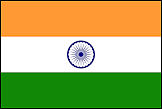
Der indische Ministerpräsident Jawaharlal Nehru ( जवाहरलाल नेहरू, geb. 1898) stirbt. Interims-Ministerpräsident bis zum 9. Juni ist Gulzarilal Nanda (गुलज़ारीलाल नन्दा, 1898 – 1998)
1964-05-30

Kurzbesuch von Dean Rusk (1909 - 1994), US Secretary of State, in Thailand.
Abb.: Dean Rusk
[Bildquelle: U.S. Department of State / Wikimedia. -- Public domain]
1964-05-30

Telegramm von Dean Rusk (1909 - 1994), US Secretary of State, an das US-Außenministerium über ein Gespräch mit General Nguyễn Khánh (1927 – 2013), Ministerpräsident Südvietnams:
Abb.: Nguyễn Khánh, 1964
[Bildquelle: Nationaal Archief / ANEFO / Wikimedia. -- http://www.gahetna.nl/collectie/afbeeldingen/fotocollectie/zoeken/weergave/detail/q/id/aa7501c2-d0b4-102d-bcf8-003048976d84 . -- Zugriff am 2015-08-10. -- Creative Commons Lizenz (Namensnennung, share alike)]
"U.S. would never again get involved in a land war in Asia limited to conventional forces. Our population was 190,000,000. Mainland China had at least 700,000,000. We would not allow ourselves to be bled white fighting them with conventional weapons. . . . This meant that if escalation brought about major Chinese attack, it would also involve use of nuclear arms. Many free world leaders would oppose this. Chiang Kai-Shek [蔣介石, 1887 - 1975] had told him fervently he did, and so did [UN Secretary- General] U Thant [သန့်, 1909 - 1974]. Many Asians seemed to see an element of racial discrimination in use of nuclear arms; something we would do to Asians but not to Westerners. Khanh replied he certainly had no quarrel with American use of nuclear arms, noted that decisive use of atomic bombs on Japan had in ending war saved not only American but also Japanese lives. One must use the force one had; if Chinese used masses of humanity, we would use superior fire power."
[Zitiert in: Ellsberg, Daniel <1931 - >: Secrets : a memoir of Vietnam and the Pentagon papers. -- New York : Viking, 2002. -- 498 S. ; 25 cm. -- ISBN 0-670-03030-9. -- S. 64]
1964-06


Die New York Times enthüllt, dass ein Teil der Piloten von North American Aviation T-28 Trojan Bodenangriffsflugzeuge über Laos Thais sind. Die Flugzeuge werden von den USA gestellt und gehören teilweise der Thai Luftwaffe.
Abb.: T-28 mit südvietnamesischem Hoheitszeichen, 1962
[Bildquelle: USAF / Wikimedia. -- Public domain]
1964-06

Es erscheint:
Phillips, Herbert P. <1929 - > ; Wilson, David A.: Certain effects of culture and social organization on internal security in Thailand. -- Santa Monica, Calif. : Rand Corp., 1964. -- 45 S. ; 28 cm. -- (Memorandum (Rand Corporation) ; RM-3786-ARPA (abridged)). -- "Research supported by the Advanced Research Projects Agency under contract no. SD-79."
1964-06-01/02


Honolulu (Hawaii): Konferenz der US-Regierung zur Lage in Laos und Südostasien:
"One such step would be consultation with allies who might contribute to a ground force contingent needed for the defense of Laos. The UK and other SEATO nations were cited as particularly important contributors. The conferees agreed, however, that contingency preparations for Laos should be undertaken outside the SEATO framework. As Secretary Rusk pointed out, "Souvanna Phouma might well call on individual SEATO nations for help, but was less likely to call on SEATO as an organization." Besides, the French and Pakistani were expected to be obstructive and the Philippines Government was regarded as presenting a constant threat of untimely leaks. Consensus was reached that the starting point for our bilateral consultations should be Thailand, since that government's confidence in the sincerity of the U.S. commitment seemed particularly needful of being shored up. At the meeting, Ambassador Martin echoed the themes which he had reported earlier in cables--that the Thais were not convinced that we meant to stop the course in Southeast Asia and probably would not participate in or permit allied troop build-ups in their country without firmer assurances than had been given in the past." [Quelle: Pentagon Papers. -- https://www.mtholyoke.edu/acad/intrel/pentagon3/pent4.htm. -- Zugriff am 2013-12-04]
1964-06-06/07

Das deutsche Albert Mangelsdorff (1928 - 2005) Quintett spielt das Album Now Jazz Ramwong ein. Der Titel ist vom populären Ramwong-Rundtanz (รำวง) genommen.
Abb.: PlattencoverDas Album auf Spotify:
URI: spotify:album:1oAbUIFaqvCNTgx6cB58nL
URL: https://open.spotify.com/album/1oAbUIFaqvCNTgx6cB58nL
"Das Album entstand nach einer Asientournee, die das Albert-Mangelsdorff-Quintett für das Goethe-Institut unternommen hatte. Von Ende Dezember 1963 bis März 1964 spielte die Band 50 Konzerte in 20 asiatischen Ländern. Das Konzept hierzu hatte Joachim-Ernst Berendt (1922 - 2000) entwickelt. Es sah vor, „Volksmusiken und populäre Stücke, die er aus verschiedenen Länder mitgebracht hatte, zu bearbeiten und als Geste dem dortigen Publikum darzubieten.“ Mangelsdorff wählte zu diesem Zweck einige Stücke aus, transkribierte sie vom Tonband und arrangierte sie. „Die vertrauten Stücke bauten dem Publikum eine Brücke zum Jazz, der in manchen Ländern, die wir bereisten, noch eine ziemlich unbekannte Sache war.“[ Wenige Monate nach der Tournee wurden die Titel im Tonstudio Walldorf von Dieter von Goetze und Detlev Kittler aufgenommen. Das Album Now Jazz Ramwong folgte 1964 als dritte Veröffentlichung in der gleichen Plattenreihe, die Horst Lippmann für das Plattenlabel CBS mit Tension gestartet hatte.
Das Titelstück Now Jazz Ramwong ist eine von thailändischer Volksmusik beeinflusste modale Komposition, bei der Heinz Sauer Sopransaxophon spielt."
[Quelle: http://de.wikipedia.org/wiki/Now_Jazz_Ramwong. -- Zugriff am 2014-09-10]
1964-06-08

Ein Flugzeug mit The Beatles (ohne Ringo Starr <1940 - >, der erkrankt ist) an Bord macht kurzen Zwischenhalt in Bangkok. Es ist nicht geplant, dass The Beatles aussteigen. Am Flugplatz sind aber Hunderte von kreischenden Fans. Deshalb überredet Fluglinienpersonal The Beatles kurz aus dem Flugzeug herauszukommen. Sie werden frenetisch begrüßt. Die meisten Fans kommen aus der International Scholl Bangkok, aber auch zahlreiche Thais sind dabei. Wenn The Beatles wieder im Flugzeug verschwinden, bricht die Schar der Fans in Tränen aus.
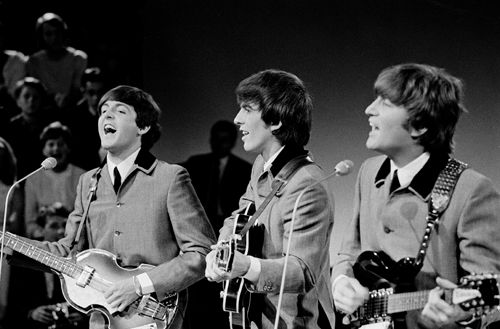
Abb.: The
Beatles: Paul McCartney (1942 - ), George Harrison (1943 - 2001), John Lennon
(1940 - 1980), Niederlande 1964
[Bildquelle: Omroepvereniging VARA /
Wikipedia. --
Creative Commons Lizenz (Namensnennung, share alike)]
1964-06-09

Lal Bahadur Shastri (लालबहादुर शास्त्री, 1904 - 1966) wird indischer Ministerpräsident.
Abb.: Ungarische Briefmarke: Lal Bahadur Shastri
[Bildquelle: Wikipedia. -- Public domain]
1964-06-09

Board of National Estimates of the CIA, Memorandum to CIA Director McCone
“The loss of South Vietnam and Laos to the Communists would be profoundly damaging to the US position in the Far East, most especially because the US had committed itself persistently, emphatically, and publicly to preventing Communist takeover of the two countries. Failure here would be damaging to US prestige, and would seriously debase the credibility of US will and capability to contain the spread of communism elsewhere in the area. Our enemies would be encouraged and there would be an increased tendency among other states to move toward a greater degree of accommodation with the Communists. . . . Aside from the immediate joy in North Vietnam over achievement of its national goals, the chief effect would be upon Communist China, both in boosting its already remarkable self-confidence and in raising its prestige as a leader of World Communism. Peiping has already begun to advertise South Vietnam as proof of its thesis that the underdeveloped world is ripe for revolution, that the US is a paper tiger, and that local insurgency can be carried through to victory without undue risk of precipitating a major international war. The outcome in South Vietnam and Laos would conspicuously support the aggressive tactical contentions of Peiping as contrasted with the more cautious position of the USSR. To some degree this will tend to encourage and strengthen the more activist revolutionary movements in various parts of the underdeveloped world.” [Zitiert in: McNamara, Robert S. (Strange) <1916 - 2009>: In retrospect : the tragedy and lessons of Vietnam. -- New York : Times, 1995. -- 414 S. : Ill. ; 24 cm. -- ISBN 0-8129-2523-8. -- S. 124f.]
1964-06-11

In seinem Exil in Tokyo (東京, Japan) stirbt der ehemalige Ministerpräsident Feldmarschall Phibun Songkhram (แปลก พิบูลสงคราม, geb. 1897). Er wird in Japan kremiert. Seine Asche wird am 27. Juni nach Thailand gebracht. König Bhumibol sponsert die buddhistischen Totenriten, an denen mehrere Tausend Personen teilnehmen.
Abb.: Lage von Tokyo (東京)
[Bildquelle: OpenStreetMap. -- Creative Commons Lizenz (Namensnennung, share alike)]
1964-06-16

Der deutsche Fußballtrainer Heinz Murach (1926 - 2007) wird für sechs Monate Haupttrainer der thailändischen Fußballnationalmannschaft (ฟุตบอลทีมชาติไทย). Er ist der erste Ausländer in dieser Position.
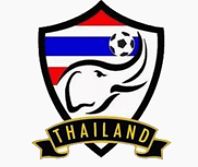
Abb.: ©Logo
1964-06-18
Eröffnung der Chiang Mai University (CMU, มหาวิทยาลัยเชียงใหม่). Im ersten Semester studieren 290 Studierende bei 61 Lehrenden in den Fakultäten für Naturwissenschaften, Geisteswissenschaften und Sozialwissenschaften. CMU ist die erste Universität in einer Provinz außerhalb Bangkoks. Geplant sind insgesamt acht Fakultäten.
Abb.: Lage von Chiang Mai (เชียงใหม่)
[Bildquelle: OpenStreetMap. -- Creative Commons Lizenz (Namensnennung, share alike)]
Abb.: Lage der Chiang Mai University (CMU, มหาวิทยาลัยเชียงใหม่)
[Bildquelle: OpenStreetMap. -- Creative Commons Lizenz (Namensnennung, share alike)]
Abb.: Haupteingang der Chiang Mai University (CMU, มหาวิทยาลัยเชียงใหม่)
[Bildquelle: Care 045 / Wikipedia. -- Public domain]
"Die Chiang Mai-Universität (Chiang Mai University, CMU, in Thai มหาวิทยาลัยเชียงใหม่, kurz als Mor Tschor gesprochen) ist die wichtigste öffentliche Universität in Nord-Thailand. Geschichte
Die Chiang Mai-Universität war das erste tertiäre Ausbildungsinstitut im Norden von Thailand und zugleich die erste Universität in einer Provinz des Landes. Die Universität wurde 1964 mit drei Fakultäten für Wissenschaften, Sozialkunde und Geisteswissenschaft gegründet.
Heute hat die Chiang Mai-Universität 17 Fakultäten mit insgesamt 107 Departments und eine Graduiertenschule. Etwa 25.000 Studenten können sich in mehr als 250 Studiengänge einschreiben, dazu zählen auch zwei internationale Bachelor und achtzehn internationale Master- und Promotionsstudiengänge. Die internationalen Studiengänge werden in englischer Sprache abgehalten und in Sozialkunde, Medizin sowie Wissenschaften und Technologie angeboten.
FakultätenDie Chiang Mai-Universität ist in siebzehn Fakultäten gegliedert:
Campus
- Fakultät für Landwirtschaft
- Fakultät für Agroindustrie
- Fakultät für Architektur
- Fakultät für Heilkunde
- Fakultät für Betriebswirtschaft
- Fakultät für Zahnheilkunde
- Fakultät für Wirtschaft
- Fakultät für Pädagogik
- Fakultät für Ingenieurwissenschaft
- Fakultät für die Schönen Künste
- Fakultät für Geisteswissenschaft
- Fakultät für Medizin
- Fakultät für Krankenpflege
- Fakultät für Pharmazie
- Fakultät für Naturwissenschaften
- Fakultät für Sozialkunde
- Fakultät für Veterinärmedizin
- Fakultät für Massenkommunikation
- College für die Innovation von Wissensarbeitern (Knowledge Workers' Innovation)
Die Chiang-Mai-Universität hat drei Campus, die zusammen etwas mehr als 14 Quadratkilometer umfassen.
Der zentrale Campus liegt etwa fünf Kilometer westlich des Stadtzentrums von Chiang Mai (ชียงใหม่) unterhalb des Berges Doi Suthep (ดอยสุเทพ). An drei Seiten wird er von Geschäftsstraßen gesäumt, an der vierten Seite befindet sich der Zoo von Chiang Mai (สวนสัตว์เชียงใหม่). Da sich hier in 1960er Jahren noch ursprünglicher Wald befand und man auf Umweltschutz Wert legte, wurden die Universitätsgebäude zwischen die Bäume gebaut, so dass heute ein beschaulicher Eindruck vorherrscht. Etwas näher zum Stadtzentrum liegt der Komplex für Medizin, wo die Fakultäten für Medizin, Zahnheilkunde, Krankenpflege und Pharmazie zusammengefasst sind. Hier steht auch das Krankenhaus Maharat Nakon Chiang Mai, von den Einheimischen Suan Dok genannt.
Etwa fünf Kilometer südlich vom Zentrum der Universität liegt der Campus Mae Ha, wo sich die Fakultäten für Veterinärmedizin und für die Agroindustrie befinden.Die neueste Erwerbung der Chiang-Mai-Universität ist der Lamphun Sri Bua Baan-Campus in der Provinz Lamphun (ลำพูน). Dieser Campus liegt etwa 55 Kilometer südlich des Hauptgeländes nahe am Lamphun-Industriezentrum. Er umfasst mehr Fläche als die anderen Campus zusammen und wird gegenwärtig (2008) ausgebaut. Hier entstehen weitere Forschungs- und Lehreinrichtungen für Krankenpflege, Architektur, Ingenieurwissenschaften, Geisteswissenschaft, Sozialkunde, Agroindustrie, Landwirtschaft, Pharmazie, veterinärmedizin, Naturwissenschaften und für die Graduiertenschule.
VeröffentlichungenSeit 2002 bringt die Chiang Mai-Universität das Chiang Mai University Journal heraus, das zweimal im Jahr erscheint und Originalbeiträge zu Naturwissenschaften, Technik und Geisteswissenschaft in englischer Sprache enthält. Im Jahr 2007 wurde die Zeitschrift in zwei getrennte Schwesterpublikationen aufgespalten (siehe unter Weblinks):
- Chiang Mai University Journal of Natural Sciences
- Chiang Mai University Journal of Social Sciences and Humanities"
[Quelle: http://de.wikipedia.org/wiki/Chiang-Mai-Universit%C3%A4t. -- Zugriff am 2011-11-10]
1964-06-24

Agrrement respecting radio communications research and development activities in Thailand.
Dies ist zusammen mit dem
Agreement respecting the establishment, conduct an support of radio communications research and development activities in Thailand vom 1965-01-19
die einzige formelle Vereinbarung der USA mit Thailand über die Tätigkeit von US Truppen in Thailand. Die beiden Abkommen erlauben den USA den Betrieb von Abhörposten in Thailand, besonders der 7th Radio Research Field Station (Ramasun Station) bei Udon (อุดร). Die Abkommen gelten bis 1976-03-20.
1964-06-25

Abkommen mit den USA über die Zuverfügungstellung von Mobile Development Units durch die USA.
1964-07

Auf der Korat (โคราช) Royal Thai Air Force Base werden ca. 500 Militärs der US Air Force stationiert. Bis Oktober 1964 werden die wichtigsten militärischen Einrichtungen gebaut. Die Wohnungen für das Militär werden wegen ihrer Primitivität als "Camp Nasty" bezeichnet.
Abb.: Lage der Korat (โคราช) Royal Thai Air Force Base
[Bildquelle: CIA. -- Public domain]
1964-07-01 - 1965-07-20

Maxwell Davenport Taylor (1901 - 1987) ist US-Botschafter in Südvietnam
Abb.: General Maxwell Davenport Taylor
[Bildquelle: US Army / Wikimedia. -- Public domain]
1964-07-03

König Bhumibol stellt sieben seiner Gemälde an der 15th National Art Exhibition aus. Sie gelten als die besten Malereien der Ausstellung. Mal-Mentor des Königs ist der Künstler Fua Hariphitak (เฟื้อ หริพิทักษ์, 1910 - ).
1964-07-04 - 1973-03


"Unity":
"Unity was the code name for Thailand's covert supply of mercenary soldiers to the Kingdom of Laos during the Laotian Civil War. From 4 July 1964 until March 1973, battalions of Thai volunteers fought Communist insurgents on the Plain of Jars (ທົ່ງໄຫຫິນ) in Military Region 2. As the Hmong L'Armée Clandestine was sapped by ongoing casualties and a limited basis for replacements, Unity battalions replaced them. By December 1970, Unity battalions also began defensive operations against People's Army of Vietnam units pushing westward from the Ho Chi Minh trail in the southern Lao panhandle. By the time the Communists defeated the Royalists in February 1973, about 18,000 Thai volunteers were serving in Laos.
OverviewThe Kingdom of Thailand occupied a delicate position during the Second Indochina War. The Kingdom of Laos was a buffer between the Peoples Republic of China and the Democratic Republic of Vietnam and Thailand, and their possible domination of the Thais. Laos also served as a buffer from the fighting in the Vietnam War. However, the Thai–Lao border of the Mekong River (ແມ່ນ້ຳຂອງ / แม่น้ำโขง) was easily breached. As a result, there was a consensus among Thais that communist encroachment should be stopped short of Thai territory. As an open effort would attract Chinese attention, the Thai government elected covert participation in the ongoing Laotian Civil War. The Police Aerial Reinforcement Unit (PARU) of the Border Patrol Police (BPP, ตำรวจตระเวนชายแดน) became the liaison agents for that.[1]
BackgroundAs early as September 1958, the Royal Thai Army (RTA) began training Lao troops at Camp Erawan, Thailand.[2] In April 1961, the first training camp in Thailand for Lao recruits opened in northeast Thailand; this effort was code named "Project Ekarad". The RTA created Headquarters 333 (HQ 333) to control its covert operations involving Laos. The Central Intelligence Agency (CIA) formed a Joint Liaison Detachment to coordinate its activities with HQ 333. Thai pilots and aviation specialists were also supplied sub rosa to the Royal Lao Air Force.[3]
Special Requirement unitsOn 4 July 1964, to prepare for the Laotian offensive Operation Triangle, a Royal Thai artillery battalion of 279 men was flown from Korat, Thailand to the Plain of Jars, Laos. Equipped with a 155mm and five 105mm howitzers, the Thai battalion was emplaced to support Kong Le's (ກອງແລ, 1934 - 2014) Forces Armées Neutralistes (FAN). The request for the Thai unit was referred to as Project 008; as the first battalion deployed, the unit was dubbed Special Requirement 1.[4]
In early 1966, Thai Prime Minister Phanom called for volunteers to serve in South Vietnam. There was an enthusiastic response from the male populace, with over 5,000 recruits just from Bangkok. It seems that this mobilization—which resulted in U.S.-funded Thai troops landing in South Vietnam in 1967—concealed the diversion of some of the manpower into Laos.[5]
Succeeding Special Requirement units served as reinforcement of FAN forces stationed at the forward all-weather air strip at Muang Soui. During Campaign Toan Thang, on 24 June 1969, when People's Army of Vietnam (PAVN) troops had scattered FAN, Special Requirement 8's 317 men manned its guns and held its ground. An evacuation of FAN dependents via helicopter sapped the Neutralist will to resist, and they abandoned Moung Soui. Encircled and outnumbered by their attackers, under tank and artillery fire, the senior Thai officer at the site had to be ordered to withdraw. On 26 June, the Thais were helilifted out in Operation Swan Lake. Special Requirement 8 was disbanded once it was back in Thailand.[6]
The Hmong L'Armée Clandestine fought three successful campaigns during 1969: Raindance, Operation Off Balance, and Kou Kiet. By the close of the latter, the Secret Army had dwindled to 5,000 to 5,500 Hmong effectives; they were faced by 22,000 Communist troops.[7][8] The Hmong manpower pool was nearly dry, as only teenagers and aging men were still available.[9] By comparison, there was an essentially bottomless pool of 10,000 replacements per year available for the Vietnamese Communists.[10]
During the Vietnamese Campaign 139, which threatened the existence of Vang Pao's (1929 - 2011) L'Armee Clandestine, 300 Thai artillerymen of Special Requirement 9 arrived at Long Tieng. They arrived on 18 March 1970, when Vang Pao's reserves were reduced to aircraft mechanics and bandsmen. They were followed in April by the RTA's 13th Regimental Combat Team, committed to a year's service in Laos. To "disguise" their assignment to Vang Pao's forces, the three infantry battalions, the new artillery battalion, and Special Requirement 9 were redesignated with French names as Lao units. Overall, the Thai units were dubbed Task Force Vang Pao. They established two fire support bases to house their artillery. As the summer progressed, units that had been transferred in from other Military Regions rotated to their home bases, and the Thai infantry replaced them in their strongholds.[11]
BeginningsIn the wake of Lon Nol's ascension to the leadership of the Khmer Republic, in early June 1970 the Royal Thai Government (RTG) raised 5,000 volunteer recruits to serve there, and began training them. On 9 September, it was publicly announced that Thailand had decided not to send troops to Cambodia after all. Undisclosed was the secret negotiation between the United States and Thailand concerning the cost and use of those troops. When Lieutenant General Richard G. Stilwell (1917 - 1991) claimed the U.S. budget for training and equipping those troops could pay for retraining the entire RTA instead, he was overridden. Department of Defense (DOD) would fund the redirection of these volunteers to Laos under the code name Unity. The CIA would train and run the Unity program. The volunteers were used to staff nine infantry battalions and an artillery battalion. Each infantry battalion would be filled with 495 recruits on a one year tour of duty. Each battalion would be stiffened with a cadre of 22 trainers and 33 medical specialists from the Thai Army. The very size of the projected Unity force was a decided escalation in Thailand's commitment in the Laotian War.[12][13] The Unity training was moved to a larger base near Kanchanaburi (กาญจนบุรี), Thailand, capable of housing four battalions at a time. There the Thais were trained by a staff of 44 U.S. Special Forces troops. Meanwhile, both the RTG and the U.S. were so enthusiastic about Unity, they contemplated an expansion of the program even beyond the tenfold increase in progress.[14]
Organization Training and deploymentThe first two battalions of these Thai mercenary volunteers were trained by early December 1970. With a dozen Royal Thai Special Forces (RTSF) as leavening in the cadre, the new units were deemed ready for service. The RLG, which had not been party to establishing Unity, now set conditions on the Thai deployment into Laos. The Thais had to be used in active operations, and they had to be far from the international press corps in Vientiane (ວຽງຈັນ). Also, the battalions had to be disguised by being renamed as Bataillon Commandos (BC) to conform with RLA custom. Numbered 601 and 602 respectively, the new battalions began the new custom of numbering Thai mercenary units in the 600 series while they were in Lao service.[15]
In June 1972, in an effort to boost recruitment for the Unity program, Thai volunteers without prior military training were accepted for service in Laos. The Unity force ballooned from a strength of 14,028 in June to 21,413 in September.[16]
Military Region 4On 15 December 1970, BC 601 and BC 602 were helilifted to the abandoned village of Houei Sai (ຫ້ວຍຊາຍ), Laos to begin military operations in Military Region 4. Operating under the code name Virakom (วีรกรรม), they were so successful that CIA case officers, noting the contrast with the Khmer troops of Project Copper, thought the Thais might recapture the Boloven Plateau (ພູພຽງບໍລະເວນ) for them.[15]
On 27 July 1971, Unity troops were committed to Operation Sayasila in a drive to recapture the vital air strip at Salavan. Later in 1971, they would participate in similar offensives in Operation Bedrock and Operation Thao La.[17] By December, the PAVN was pressuring the Royalists in operations designed to push them away from the Ho Chi Minh Trail and backwards toward Thailand.[18]
By June 1972, Royalist defenses in southern Laos' panhandle had been beaten back until some Communist troops had pushed to the Mekong River border between Laos and Thailand. Unity troops were being shifted between Military Regions 2 and 4 to fend off increasing PAVN might. The Royalist Black Lion offensives—Operations Black Lion, Black Lion III, and Black Lion V—were waged from 15 June 1972 through 22 February 1973 in a vain attempt to stave off defeat. The Thai mercenaries made up most of the Royalist fighting force.[19]
Military Region 2The Royalists faced many difficulties in Military Region 2. Fire Support Base Puncher, the Ban Na outpost of Long Tieng, was surrounded by PAVN infantry and sappers. On 14 February 1971, an accidental bombing killed 30 civilians. By 15 February, Vang Pao's L'Armee Clandestine was in desperate shape. The PAVN were within striking distance of the main guerrilla base at Long Tieng. The next two Unity Battalions, BCs 603 and 604, were pulled from the final stages of training and sent to reinforce the Hmong irregulars. To maintain unit integrity, the Thais had to fend off Vang Pao's attempt to parcel out platoons of Thai replacements into Hmong guerrilla units. The Thais were trained to fight cohesively as mobile offensive troops, and they intended to retain that capability.[20]
On 3 March, the first Thai battalions arrived at Long Tieng.[14] Unity troops held the line through March; PAVN could not overrun Long Tieng and win the war before the rainy season quashed operations.[21]
Unity battalions continued to transfer into MR 2. The Thais recaptured the advanced fighter base at Muang Soui by late September 1971. The Thais had also set up a network of artillery fire support bases with mutually interlocking fields of fire across the expanse of the Plain of Jars to defend it against the Communists.[22]
Also in late September, the Unity forces had increased to the point where they rated their medical evacuation support. Ten armed UH-1M helicopters were acquired and stationed at Udorn RTAFB; 26 Thai pilots were trained to fly them. As many as six of the helicopters would fly north daily to the Plain, responding to the call sign White Horse.[23]
By the end of 1971, when the Vietnamese launched Campaign Z, the Thai troops in L'Armee Clandestine had largely replaced the original Hmong militia. Although the Communist combined arms assault initially overran six Thai strongpoints, the Thai defense of the vital base at Long Tieng narrowly saved the Royalists from losing the war.[24] The Thais were also the backbone of the Operation Strength and Operation Strength II Royalist counteroffensives of February and March 1972.[25] By May 1972, the Hmong manpower pool was so diminished that a CIA paramilitary adviser noted that his newly recruited battalion of guerrillas contained over 100 youths under 17 years of age, with about a dozen being 12 or younger. Indeed, with six percent of the Lao population under arms, the Royalists were running low on potential soldiers, regardless of ethnic background. As a result, the Unity force supplied most of the manpower for Operation Phou Phiang II[26] and Operation Phou Phiang III. The last of the Thai battalions would remain in the field through the 22 February 1972 ceasefire, withdrawing in March.[27]
ResultsIn contrast to the 11,000 Thai troops who served in South Vietnam, as many as 22,000 Thais may have served in Laos by 1971. Thai casualty figures are reported as 350 killed, and over 1,000 wounded.[28] When the ceasefire ended the war on 22 February 1973, Unity consisted of 27 infantry and three artillery battalions, along with six heavy weapon companies. The Thai units were organized into three task forces. Total strength then stood at 17,808 troopers. With fighting ended, desertion began. Within a month, Thai strength dropped to 14,900 as the volunteers filtered south looking for fresh employment. By midyear, Unity had dwindled to 10,000 soldiers. They were removed from Laos during the next year. Although there was some thought of redirecting some Unity troops into the Cambodian theater, eventually they were discharged."[Quelle: https://en.wikipedia.org/wiki/Unity_(military_operation). -- Zugriff am 2016-09-23]
1964-07-11
Die Polizei bewahrt Thailand vor einer drohenden Modeschau mit busenfreien ("oben ohne") Frauen. Dieses Verbot ist Ausdruck der Sorge um Thai-Werte, die durch Bikinis und andere Fleisch-enthüllende Modetrends gefährdet werden.
Abb.: Schon wieder eine äußere Bedrohung Thailands: Entwurf zum Monokini von Rudi Gernreich
[Bildquelle: *Ulla* / Wikipedia. -- Public domain]
1964-07-21
Fünf Thai-Berufs-Models - The Maids of Siam - , die zuvor in Malaysia und Hong Kong aufgetreten waren, gehen im Oriental Hotel über den Laufsteg. Es sind die ersten Thai-Berufs-Models, die im Ausland aufgetreten sind. Die Namen dieser Pionierinnen sind:
1964-08 - 1975-06-30

Die US Air Force bezieht in großem Maße die Nakhon Phanom (นครพนม) Royal Thai Air Force Base.
In der Nakhon Phanom (นครพนม) Royal Thai Air Force Base sind u.a. Flugzeuge folgender Typen stationiert:
- Jagdbomber Douglas A-1E/G/H/J Skyraider
- Leichter Bomber Douglas A-26A Invader
- Kampfflugzeug Douglas C-47/EC-47 Skytrain
- Zweimotoriges Transportflugzeug Fairchild AC-119K
- Transportflugzeug Fairchild AC-123K Provider
- Trainingsflugzeug North American T-28 Trojan
- Leichtflugzeug Cessna O-1 Bird Dog
- Leichtflugzeug Cessna O-2 Skymaster
- Leichtes Angriffs- und Transportflugzeug North American OV-10 Bronco
- Mehrzweckhubschrauber Sikorsky CH-3E Sea King
- Transporthubschrauber Sikorsky HH-53 Super Jolly Green Giant
Außerdem noch folgende "Zivilflugzeuge" für getarnte Aktionen (besonders in Laos):
- Leichtflugzeug Cessna 185
- Leichtflugzeug Cessna Skymaster
- Schweizer STOL Mehrzweckflugzeug Pilatus PC-6
- STOL Mehrzweckflugzeug Helio Courier,
- STOL-Transportflugzeug de Havilland DHC-4
- Passagier- und Transportflugzeug Douglas DC-3
Abb.: Lage der Nakhon Phanom (นครพนม) Royal Thai Air Force Base
[Bildquelle: CIA. -- Public domain]
Abb.: Jagdbomber Douglas A-1H Skyraider mit Bomben über Vietnam, 1970-06
[Bildquelle: USAF / Wikipedia. -- Public domain]
Abb.: Leichter Bomber Douglas A-26A Invader bei Nakhon Phanom (นครพนม)
[Bildquelle: USAF / Wikipedia. -- Public domain]
Abb.: Kampfflugzeug Douglas C-47/EC-47 Skytrain
[Bildquelle: USAF / Wikipedia. -- Public domain]
Abb.: Zweimotoriges Transportflugzeug Fairchild C-119
[Bildquelle: USAF / Wikipedia. -- Public domain]
Abb.: Transportflugzeug Fairchild AC-123K Provider über Südvietnam, 1969-03-27
[Bildquelle: USAF / Wikipedia. -- Public domain]
Abb.: Trainingsflugzeug North American T-28 Trojan: "U.S. North American T-28D Nomad COIN-aircraft involed in the fighting in Laos, 1964-1973. U.S. Air Force T-28Ds from the 56th Special Operations Wing from Nakhon Phanom RTAFB took part in "Operation Barrel Roll" a covert interdiction and close air support campaign conducted in the Kingdom of Laos. Others were supplied to the Royal Laotian Air Force under "Project 404" or "Palace Dog" and flown by Laotian and U.S. pilots."
[Bildquelle: USAF / Wikipedia. -- Public domain9
Abb.: Leichtflugzeug Cessna O-1 Bird Dog: "A U.S. Air Force Cessna 0-1E Bird Dog aircraft (s/n 56-4200) in flight over Vietnam in 1967. The aircraft was used as a forward air control aircraft throughout South Vietnam. The forward air controller (FAC) spotted suspected enemy strongholds and fired smoke rockets to mark the target for strike aircraft. Following a strike the FAC assessed bomb damage.", 1967
[Bildquelle: USAF / Wikipedia. -- Public domain]
Abb.: Leichtflugzeug Cessna O-2 Skymaster wirft Flugblätter über Südvietnam ab, 1970
[Bildquelle: USAF / Wikipedia. -- Public domain]
Abb.: Leichtes Angriffs- und Transportflugzeug North American OV-10 Bronco wirft weißen Phosphor ab, um ein Ziel für die Bomber zu markieren, 1985
[Bildquelle: USAF / Wikimedia. -- Public domain]
Abb.: Transporthubschrauber Sikorsky HH-53 Super Jolly Green Giant: "Two U.S. Air Force 20th Special Operations Squadron Sikorsky HH-53C Super Jolly Green Giant helicopters refueling from a 55th Aerospace Rescue and Recovery Squadron Lockheed HC-130P Hercules aircraft on 27 May 1987."
[Bildquelle: USAF / Wikimedia. -- Public domain]"Zivilflugzeuge":
Abb.: Leichtflugzeug Cessna 185, 2005
[Bildquelle: CambridgeBayWeather / Wikipedia. -- Public domain]
Abb.: Leichtflugzeug Cessna Skymaster über Laos, 1970
[Bildquelle. USAF / Wikimedia. -- Public domain]
Abb.: STOL Mehrzweckflugzeug Pilatus PC-6 der CIA-Fluggesellschaft Air America in Laos, ca. 1970
[Bildquelle: Wikipedia. -- Public domain]
Abb.: STOL Mehrzweckflugzeug Helio Courier in Laos
[Bildquelle: Wikipedia. -- Public domain]
Abb.: STOL-Transportflugzeug de Havilland DHC-4 über Vietnam, 1967-01
[Bildquelle: USAF / Wikimedia. -- Public domain]
Abb.: Passagier- und Transportflugzeug Douglas DC-3, Schweden, 1989
[Bildquelle: Towpilot / Wikimedia. -- GNU FDLicense]
1964-08

Zum Beispiel: Bombardierung des Ho-Chi-Minh-Pfads in Laos von US T-28 Trojan Flugzeugen aus.
Abb.: Vietnamesisches T-28 Trojan, 1962
[Bildquelle: USAF / Wikipedia. -- Public domain]
1964-08-04

Radioansprache von US-Präsident Lyndon B. Johnson (1908 - 1973) an das amerikanische Volk:
"My fellow Americans: As President and Commander in Chief, it is my duty to the American people to report that renewed hostile actions against United States ships on the high seas in the Gulf of Tonkin have today required me to order the military forces of the United States to take action in reply.
The initial attack on the destroyer Maddox, on August 2, was repeated today by a number of hostile vessels attacking two U.S. destroyers with torpedoes. The destroyers and supporting aircraft acted at once on the orders I gave after the initial act of aggression. We believe at least two of the attacking boats were sunk. There were no U.S. losses.
The performance of commanders and crews in this engagement is in the highest tradition of the United States Navy. But repeated acts of violence against the Armed Forces of the United States must be met not only with alert defense, but with positive reply. That reply is being given as I speak to you tonight. Air action is now in execution against gunboats and certain supporting facilities in North Viet-Nam which have been used in these hostile operations.
In the larger sense this new act of aggression, aimed directly at our own forces, again brings home to all of us in the United States the importance of the struggle for peace and security in southeast Asia. Aggression by terror against the peaceful villagers of South Viet-Nam has now been joined by open aggression on the high seas against the United States of America.
The determination of all Americans to carry out our full commitment to the people and to the government of South Viet-Nam will be redoubled by this outrage. Yet our response, for the present, will be limited and fitting. We Americans know, although others appear to forget, the risks of spreading conflict. We still seek no wider war.
I have instructed the Secretary of State to make this position totally clear to friends and to adversaries and, indeed, to all. I have instructed Ambassador Stevenson to raise this matter immediately and urgently before the Security Council of the United Nations. Finally, I have today met with the leaders of both parties in the Congress of the United States and I have informed them that I shall immediately request the Congress to pass a resolution making it clear that our Government is united in its determination to take all necessary measures in support of freedom and in defense of peace in southeast Asia.
I have been given encouraging assurance by these leaders of both parties that such a resolution will be promptly introduced, freely and expeditiously debated, and passed with overwhelming support. And just a few minutes ago I was able to reach Senator Goldwater and I am glad to say that he has expressed his support of the statement that I am making to you tonight.
It is a solemn responsibility to have to order even limited military action by forces whose overall strength is as vast and as awesome as those of the United States of America, but it is my considered conviction, shared throughout your Government, that firmness in the right is indispensable today for peace; that firmness will always be measured. Its mission is peace."
[Quelle: Lyndon B. Johnson <1908 - 1973>: "Radio and Television Report to the American People Following Renewed Aggression in the Gulf of Tonkin," August 4, 1964. Online by Gerhard Peters and John T. Woolley, The American Presidency Project. http://www.presidency.ucsb.edu/ws/?pid=26418]
1964-08-07

Die Tonkin Resolution (Gulf of Tonkin Resolution, officially, the Southeast Asia Resolution, Public Law 88-408) von US Kongress und Repräsentantenhaus bevollmächtigt Präsident Lyndon B. Johnson zum offiziellen Kriegseintritt mit Nordvietnam. Die Luftwaffenstützpunkte der USA in Thailand werden mit Kampfflugzeugen verstärkt.
Abb.: US-Luftwaffenstützpunkte 1970
[Bildquelle: CIA. -- Public domain]
Abb.: Schlagzeile in Pacific Stars and Stripes, 1964-08-08
[Bildquelle: Wikipedia. -- Public domain]
" 88TH UNITED STATES CONGRESS
1ST SESSIONJoint Resolution
To promote the maintenance of international peace and security in southeast Asia.
Sec. 2.
- Whereas naval units of the Communist regime in Vietnam, in violation of the principles of the Charter of the United Nations and of international law, have deliberately and repeatedly attacked United States naval vessels lawfully present in international waters, and have thereby created a serious threat to international peace; and
- Whereas theses attacks are part of a deliberate and systematic campaign of aggression that the Communist regime in North Vietnam has been waging against its neighbors and the nations joined with them in the collective defense of their freedom; and
- Whereas the United States is assisting the peoples of southeast Asia to protect their freedom and has no territorial, military or political ambitions in that area, but desires only that these peoples should be left in peace to work out their own destinies in their own way: Now, therefore, be it
- Resolved by the Senate and House of Representatives of the United States of America in Congress assembled. That the Congress approves and supports the determination of the President, as Commander in Chief, to take all necessary measures to repel any armed attack against the forces of the United States and to prevent further aggression.
Sec. 3.
- The United States regards as vital to its national interest and to world peace the maintenance of international peace and security in southeast Asia. Consonant with the Constitution of the United States and the Charter of the United Nations and in accordance with its obligations under the Southeast Asia Collective Defense Treaty, the United States is, therefore, prepared, as the President determines, to take all necessary steps, including the use of armed force, to assist any member or protocol state of the Southeast Asia Collective Defense Treaty requesting assistance in defense of its freedom.
- This resolution shall expire when the President shall determine that the peace and security of the area is reasonably assured by international conditions created by action of the United Nations or otherwise, except that it may be terminated earlier by concurrent resolution of the Congress."
Approved August 10, 1964"
[Quelle: http://en.wikisource.org/wiki/Gulf_of_Tonkin_Resolution. -- Zugriff am 2011-11-09. -- Public domain]
1964-08-12

US-Präsident Lyndon B. Johnson (1908 - 1973): Remarks in New York City Before the American Bar Association
"Since the end of World War II, America has been found wherever freedom was under attack, or wherever world peace was threatened. The stage has shifted many times.
The stakes have grown as man's capacity for destruction grew. But America's role has not changed. With constancy we have pursued the defense of freedom and we have prevented nuclear destruction. We have patiently labored to construct a world order in which both peace and freedom could flourish.
We have lived so long with crisis and danger that we accept, almost without division, the premise of American concern for threats to order.
Yet this is a unique responsibility--unique for America, and unique in history.
We accepted this responsibility, first, because at one time no other nation could do it. For the last 20 years, only under the shadow of our strength could friends keep their freedom and build their nation. Now that our allies have been restored to strength, they must share our responsibility in the pursuit of common purpose.
We have done this because we have, at painful cost, learned that we can no longer wait for the tides of conflict to touch our shores. Aggression and upheaval, in any part of the world, carry the seeds of destruction to our own freedom and perhaps to civilization itself.
We have done this, lastly, for a reason that is often difficult for others to understand. We have done it because it is right that we should.
Friendly cynics and fierce enemies alike often underestimate or ignore the strong thread of moral purpose which runs through the fabric of American history.
Of course, our security and welfare shape our policies. But much of the energy of our efforts has come from moral purpose.
It is right that the strong should help the weak defend their freedom.
It is right that the wealthy should help the poor emerge from their hunger.
It is right that help and understanding should flow from friendship and loyalty.
It is right that nations should be free from the coercion of others.
That these truths may coincide with interest does not make them less true. "
[Quelle: http://www.presidency.ucsb.edu/ws/?pid=26434. -- Zugriff am 2016-07-01]
1964-08-14

Auf der Korat (โคราช) Royal Thai Air Force Base werden achtzehn einstrahlige Kampfflugzeuge Republic F-105 Thunderchief des US 36th Fighter Squadron (36 FS) stationiert und am folgenden Tag eingesetzt.
Abb.: ®Patch
[Bildquelle: Wikipedia. -- Public domain]
Abb.: Ein Republic F-105 Thunderchief wird auf der Auf der Korat (โคราช) Royal Thai Air Force Base mit Bomben für die Bombardierung Vietnams beladen, 1964
[Bildquelle: USAF / Wikipedia. -- Public domain]
1964-08-18
Eröffnung des Bangkok Planetarium (ท้องฟ้าจำลองกรุงเทพ). Es hat einen Mark IV Zeiss-Projektor.
Abb.: Lage des Bangkok Planetarium (ท้องฟ้าจำลองกรุงเทพ)
[Bildquelle: OpenStreetMap. -- Creative Commons Lizenz (Namensnennung, share alike)]
Abb.: Bangkok Planetarium (ท้องฟ้าจำลองกรุงเทพ), 2009
[Bildquelle: Paul_012 / Wikipedia. -- GNU FDLicense]
1964-08-19

Der erste geostationäre Kommunikations-Satellit der Welt, Syncom 3, wird in seine Bahn geschossen. Er dient u.a. der Fernseh-Übertragung der Olympischen Sommerspiele in Tokyo (1964) in die USA.
Abb.: Syncom III
[Bildquelle: Wikimedia. -- Public domain]
1964-08-26


Telegramm von US-Außenminister Dean Rusk (1909 - 1994) an die US-Botschaft in Laos: "Importance of Air America Missions"
Abb.: North American T-28D Trojan der Air America, Thailand
[Bildquelel: USAF / Wikimedia. -- Public domain]
"State Cable
[addressee missing]We agree with your assessment of importance SAR [Search and Rescue] operations that Air America pilots can play critically important role, and that SAR efforts should not discriminate between rescuing Americans, Thais and Lao. You are also hereby granted as requested discretionary authority to use AA [Air America] pilots in T-28's [North American T-28 Trojan Trainingsflugzeug]for SAR operations when you consider this indispensable rpt indispensable to success of operation and with understanding that you will seek advance Washington authorization wherever situation permits.
At same time, we believe time has come to review scope and control arrangements for T-28 operations extending into future. Such a review is especially indicated view fact that these operations more or less automatically impose demands for use of US personnel in SAR operations. Moreover, increased AA capability clearly means possibilities of loss somewhat increased, and each loss with accompanying SAR operations involves chance of escalation from one action to another in ways that may not be desirable in wider picture. On other side, we naturally recognize T-28 operations are vital both for their military and psychological effects in Laos and as negotiating card in support of Souvanna's position. Request your view whether balance of above factors would call for some reduction in scale of operations and/or dropping of some of better-defended targets. (Possible extension T-28 operations to Panhandle would be separate issue and will be covered by septel.)
On control problem, our understanding is that Thai pilots fly missions strictly controlled by your Air Command Center with AIRA in effective control, but that this not true of Lao pilots. We have impression latter not really under any kind of firm control.
Request your evaluation and recommendations as to future scope T-28 operations and your comments as to whether our impressions present control structure correct and whether steps could be taken to tighten this.
End
RUSK"[Quelle: Pentagon Papers. -- https://www.mtholyoke.edu/acad/intrel/pentagon3/doc184.htm. -- Zugriff am 2013-12-04]
1964-09-03


Der König legt den Grundstein für das SEATO-Hauptquartier in Bangkok.
1964-09-03

John Theodore McNaughton (1921 –1967), United States Assistant Secretary of Defense for International Security Affairs, schlägt vor
"to provoke a military DRV [Democratic Republic of Vietnam] response and to be in a good position to seize on that response ... to commence a crescendo of GVN [Government of Vietnam] - U.S. military actions against the DRV"
the highest officials forwarded the proposal to the president for his decision. After recommending the immediate resumption of DeSoto [DeHaven Special Operations off TsingtaO] patrols off the coast of North Vietnam and the resumption of 34A actions [verdeckte Aktionen gegen Nordvietnam], both suspended since August 5, they added:
"The main further question is the extent to which we should add elements to the above actions that would tend deliberately to provoke a DRV reaction, and consequent retaliation by us. Examples of actions to be considered would be running U.S. naval patrols increasingly close to the North Vietnamese coast and/or associating them with 34A operations."
[Quelle: Ellsberg, Daniel <1931 - >: Secrets : a memoir of Vietnam and the Pentagon papers. -- New York : Viking, 2002. -- 498 S. ; 25 cm. -- ISBN 0-670-03030-9. -- S. 65]
Der Vorschlag wird von höchsten Beamten dem Präsidenten zur Entscheidung vorgelegt.
1964-09-03



Großbritannien verspricht Malaysia militärische Unterstützung gegen die Aggression Indonesiens.
1964-09-04
Nach langer Zeit wird wieder ein Thai-Drama aufgeführt: "Chantra Kinnaree" im Auditorium der Thammasat Universität (มหาวิทยาลัยธรรมศาสตร์). Bei der Premiere sind das Königspaar und fast die ganze Oberschicht Bangkoks anwesen.
1964-09-05
Tod des Autors Luang Bunyamanopphanit (หลวงบุณยมานพพานิชย์ aka. อรุณ บุณยมานพ aka. แสงทอง, 1893 - 1964)
Abb.: Einbandtitel des Souvenirs der Kremation, 1964
[Fair use]
1964-09-06


Telegramm des US-Außenministeriums und des US-Verteidigungsministerium an die US-Botschaft in laos mit Kopien an die Botschaften in Thailand und Südvietnam: Erlaubnis zu Luftangriffen auf Laos
Abb.: Lage des Panhandle ("Pfannenstiel")
[Bildquelel: USACMH / Wikipedia. -- Public domain]
"Ref: Deptel 275 to Vientiane and Vientiane's 545, 550, 568 and 581 JOINT STATE-DEFENSE MESSAGE
EXDIS
You are authorized to urge the RLG [Royal Lao Government] to begin air attacks against Viet Cong infiltration routes and facilities in the Laos Panhandle by RLAF [Royal Lao Air Force] T-28 aircraft as soon as possible. Such strikes should be spread out over a period of several weeks, and targets should be limited to these deemed suitable for attack by T-28s and listed Para. 8 Vientiane's 581, (excluding Mu Gia pass and any target which Lao will not hit without U.S. air cover or fire support) since decision this matter not yet made.You are further authorized to inform Lao that YANKEE TEAM suppressive fire strikes against certain difficult targets in Panhandle, interspersing with further T-28 strikes, are part of the over-all concept and are to be anticipated later but that such US strikes are not repeat not authorized at this time.
Report soonest proposed schedule of strikes and, upon implementation, all actual commitments of RLG T-28s, including targets attacked, results achieved, and enemy opposition. Also give us any views in addition to those in Vientiane's 581 as to any targets which are deemed too difficult for RLG air strikes and on which US suppressive strikes desired.
FYI: Highest levels have not authorized YANKEE TEAM strikes at this time against Route 7 targets. Since we wish to avoid the impression that we are taking first step in escalation, we inclined defer decision on Route 7 strikes until we have strong evidence Hanoi's preparation for new attack in PDJ, some of which might come from RLAF operations over the Route. END FYI.
You may inform RLG, however, that US will fly additional RECCE over Route 7 to keep current on use being made of the Route by the PL and to identify Route 7 targets and air defenses. The subject of possible decision to conduct strikes on Route 7 being given study in Washington.
FYI: Cross border ground operations not repeat not authorized at this time. End FYI."
[Quelle: Pentagon Papers. -- https://www.mtholyoke.edu/acad/intrel/pentagon3/doc204.htm. -- Zugriff am 2013-12-04]
Abb.: Route 7
[Bildquelle: CIA. -- Public Domain]
1964-09-12 - 1962-10-06

Das Königspaar ist auf Staatsbesuch in
- Schweiz
- Griechenland
- Österreich
Regentin ist während dieser Zeit die Mutter König Bhumibols.
Abb.: Lage von Schweiz, Österreich, Griechenland
[Bildquelle: San Jose / Wikipedia. -- GNU FDLicense]
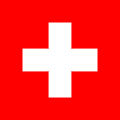
Der König hält sich zwei Wochen in der Schweiz auf. Seine Residenz ist das Hotel Beau-Rivage Palace in Lausanne. Bundespräsident: Ludwig von Moos (1910 - 1990)
Abb.: Ludwig von Moos
[Bildquelle: Wikimedia]
Abb.: Lage des Hotel Beau-Rivage Palace
[Bildquelle: OpenStreetMap. -- Creative Commons Lizenz (Namensnennung, share alike)]
Abb.: Hotel Beau-Rivage Palace in Ouchy, Lausanne
[Bildquelle: Panoramasuisse / Wikimedia. -- Creative Commons Lizenz (Namensnennung, share alike)]
1964-09-18 -
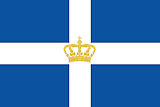
Das Königspaar ist auf Staatsbesuch in Griechenland. König: Konstantin II. (Κωνσταντῖνος Βʹ, 1940 - )
Abb.: Kronprinz Konstantin (Κωνσταντῖνος), 1959
[Bildquelle: White House / Wikimedia. -- Public domain]
1964-09-29 - 1964-10-06
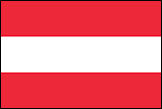
Das Königspaar weilt auf Staatsbesuch in Österreich. Bundespräsident: Adolf Schärf (1890 - 1965)
Abb.: Adolf Schärf, 1961
[Bildquelle: Wim van Rossem / Anefo / Wikimedia. -- Creative Commons Lizenz (Namensnennung, share alike)]Das Königspaar besucht
- Wien, u.a.
- Stephansdom
- Schatzkammer
- SOS Kinderdorf
- Spanische Hofreitschule
- Hofburg
- Rathaus
- Mozarts "Die Hochzeit des Figaro"
- Linz: VÖST
- Salzburg
In Wien führen die Wiener Philharmoniker im Goldenen Saal des Wiener Musikverein folgende Werke des Königs auf:
- Kinari Suite (ภิรมย์รัก)
- Sai Fon (สายฝน)
Der Song auf Spotify:
URI: spotify:track:3UG8mbJ8G5GqFOyQUvfRag
URL: https://open.spotify.com/track/3UG8mbJ8G5GqFOyQUvfRag- Yarm Yen (ยามเย็น)
- Royal Marines March (มาร์ชราชนาวิกโยธิน)
- Royal Guards March (มาร์ชราชวัลลภ)
Das Konzert wird im österreichischen Rundfunk übertragen.
Am 5. Oktober 1964 wird seine Majestät zum Ehrenmitglied der Akademie für Musik und Darstellende Kunst in Wien ernannt.
Abb.: Lage von Wien
[Bildquelle: OpenStreetMap. -- Creative Commons Lizenz (Namensnennung, share alike)]
Abb.: Tafel der Ehrenmitglieder der Akademie für Musik und Darstellende Kunst in Wien
1964-09-16
Die Polizei entlässt drei Journalisten, die seit Oktober 1958 wegen Verdachts auf Kommunismus in Haft waren:
- Uthorn Polakun, der in den vergangenen 11 Jahren 9 Jahre in Haft war
- Udom Srisuwan (อุดม ศรีสุวรรณ)
- Isra Amantakul (อิศรา อมันตกุล) (1920 -1969)
Abb.: Isra Amantakul (อิศรา อมันตกุล)
[Bildquelle: th.Wikipedia. -- Fair use]
1964-09-17
50 "führende Thai-Frauen" rufen dazu auf, dass Frauen Thai-Güter kaufen statt ausländischer Ware. Der Kauf von Thai-Textilien schütze die Arbeitsplätze von 400.000 Frauen.
1964-09-24
Überschwemmungen in den Provinzen Chaiyaphum (ชัยภูมิ), Phetchabun (เพชรบูรณ์), Roi Et (ร้อยเอ็ด) und Saraburi (สระบุรี). In Petchabun fallen in 24 Stunden 143 mm Regen. Ca. 30.000 Personen verlieren in Saraburi (สระบุรี) ihre Behausung: viele Orte sind 3 - 4 m unter Wasser.
Abb.: Lage der Provinzen Chaiyaphum (ชัยภูมิ), Phetchabun (เพชรบูรณ์), Roi Et (ร้อยเอ็ด) und Saraburi (สระบุรี)
[Bildquelle: CIA. -- Public domain]
1964-09-29

16 Mann der Royal Thai Air Force landen in Vietnam, um Transportflugzeuge der South Vietnamese Air Force zu fliegen und zu warten. Die Royal Thai Airforce hilft auch bei der Ausbildung vietnamesischer Piloten.
1964-10 - - 1975-12-23

Starke Präsenz der US Air Force auf der Udorn (อุดรธานี) Royal Thai Air Force Base.
Abb.: Lage der Udorn (อุดรธานี) Royal Thai Air Force Base
[Bildquelle: OpenStreetMap. -- Creative Commons Lizenz (Namensnennung, share alike)]Wichtige Flugzeugtypen, die von Udorn aus operieren:
- Jagdflugzeug McDonnell RF-101C Voodoo (1966–1967)
- Jagdbomber McDonnell Douglas F-4 Phantom II (1967-1975)
- Aufklärer McDonnell Douglas RF-4C Phantom II (1966–1975)
- Douglas RC-47 (1966–1969)
- "Gunship" Douglas AC-47 (1969–1970)
Abb.: Jagdflugzeug McDonnell RF-101C Voodoo, Vietnamkrieg, 1967
[Bildquelel: USAF / Wikipedia. -- Public domain]
Abb.: Jagdbomber McDonnell Douglas F-4 Phantom II, Udiorn, 1972-01-20
[Bildquelle: USAF / Wikipedia. -- Public domain]
Abb.: Aufklärer McDonnell Douglas RF-4C Phantom II, Udorn
[Bildquelel: Wikipedia. -- Public domain9
Abb.: Douglas RC-47
Abb.: "Gunship" Douglas AC-47: "A U.S. Air Force Douglas AC-47D Spooky gunship (s/n 43-49010) of the 4th Special Operations Squadron at Udorn Royal Thai Air Force Base, in June 1970. This aircraft was turned over to the Royal Laotian air force on 8 June 1970. It later served with the Cambodian Royal Khmer Air Force before it finally served with the Royal Thai air force as "L2-46/18" in 1975. It was retired on 23 April 1991 and was derelict at Don Muang air base by 1995. Today it is displayed at the Vietnam War Veterans Memorial Museum, Surasri Army Camp, Kanchanaburi, Thailand.", 1970-06
[Bildquelle: Fly-by-Owen / Wikipedia. -- GNU FDLicense]
1964-10-01 - 1973-10-01
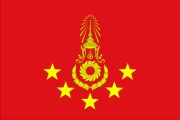
Field Marshal Praphas Charusathien (จอมพล ประภาส จารุเสถียร, 1912 - 1997) ist Commander-in-Chief of the Royal Thai Army (ผู้บัญชาการทหารบก)
Abb.: Praphas Charusathien (จอมพล ประภาส จารุเสถียร)
[Bildquelle: th.Wikipedia. -- Fair use]
1964-10-01
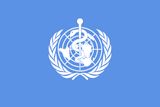
Tuberkulose-Impfung:
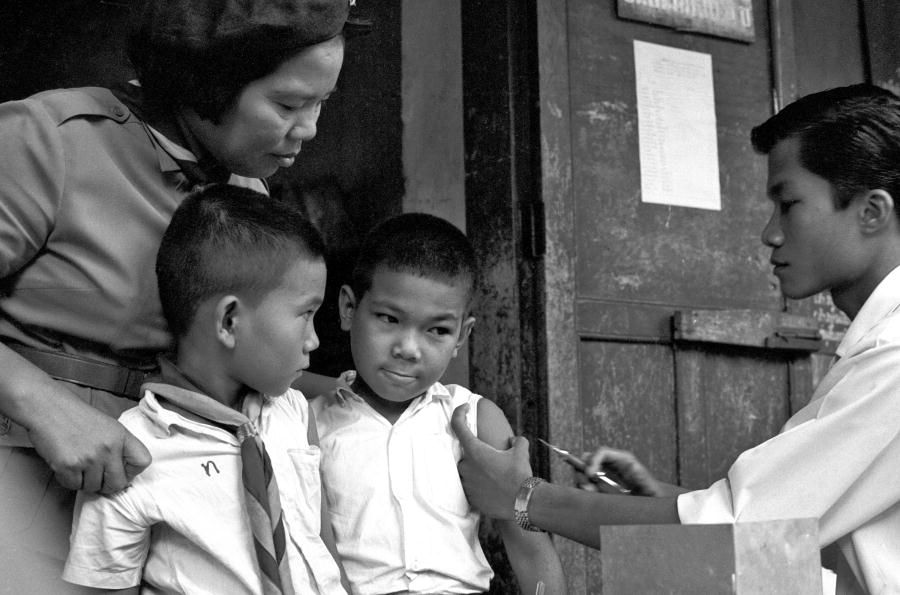
Abb.: "The
Government has been establishing pilot projects in Bangkok and in rural areas to
demonstrate the organization of case-finding and treatment services for
tuberculosis and to provide a training field for Thai personnel. The programme,
which is aided by the World Health Organization (WHO), also is developing an
epidemiological centre for the collection of information on the problem of TB in
Thailand.
A child is given a BCG vaccination by a member of a TB health team.
October 1964.
1/Oct/1964."
[Bildquelle: UN Photo/MS. --
http://www.flickr.com/photos/un_photo/3836440233/. -- Zugriff am 2013-03-18.
--
Creative Commons
Lizenz (Namensnennung, keine komerzielle Nutzung, keine Bearbeitung)]
1964-10-01

Eine hochrangige Delegation Malaysias kommt nach Bangkok zu Gesprächen über die Grenzprobleme zwischen Thailand und Malaysia.
1964-10-03


Das Tonkünstler-Orchester Niederösterreich führt König Bhumibols Koposition Falling Rain - สายฝน (1946-05) auf; Thai-Text von Prinz Chakrabandh Pensiri (พระเจ้าวรวงศ์เธอ พระองค์เจ้าจักรพันธ์เพ็ญศิริ, 1909 - 1993); englischer Text von Prof. Thanphuying Nopakhun Thongyai Na Ayudhya (ท่านผู้หญิงนพคุณ ทองใหญ่ ณ อยุธยา, 1915 - 1992); Orchestrierung von Khru Euah Sunthornsanan (ครูเอื้อ สุนทรสนาน, 1910 - 1981). Die Aufführung wird vom österreichischen Rundfunk übertragen.
Der Song auf Spotify:
URI: spotify:track:3UG8mbJ8G5GqFOyQUvfRag
URL: https://open.spotify.com/track/3UG8mbJ8G5GqFOyQUvfRag
1964-10-10 - 1964-10-24
XVIII. Olympische Sommerspiele in Tokyo (東京). Thailand nimmt mit 78 Sportlern und 51 Funktionären teil, gewinnt aber keine Medaillen.
Abb.: Lage von Tokyo (東京)
[Bildquelle: OpenStreetMap. -- Creative Commons Lizenz (Namensnennung, share alike)]
1964-10-13
Wegen großer Korruptionsskandale wird das staatliche Schweinefleisch-Monopol beendet.
1964-10-14 - 1982-11-10

Leonid Iljitsch Breschnew (Леонид Ильич Брежнев, 1907 - 1982) ist Parteichef der Kommunistischen Partei der Sowjetunion.
Abb.: Leonid Iljitsch Breschnew (Леонид Ильич Брежнев) / von Edmund S. Valtman (1914 - 2005), 1968
[Bildquelle: LoC / Wikimedia. -- Public domain]
1964-10-15 - 1980-10-23

Alexei Nikolajewitsch Kossygin (Алексей Николаевич Косыгин, 1904 - 1980) ist Ministerpräsident der Sowjetunion.
Abb.: Alexei Nikolajewitsch Kossygin (Алексей Николаевич Косыгин), 1967
[Bildquelle: LBJ Library photo by Yoichi R. Okamoto / Wikipedia. -- Public domain]
1964-10-16

Rotchina testet seine erste Atombombe.
Abb.: Modell der ersten chinesischen Atombombe
[Bildquelle: Max Smith / Wikipedia. -- Public domain]
1964-10-21

US-Präsident Lyndon Johnson in einer Rede vor Stduenten der Akron University (Ohio):
"But we are not about to send American boys 9 or 10,000 miles away from home to do what Asian boys ought to be doing for themselves."
1964-10-28

Unterzeichnung eines Abkommens mit der BR Deutschland über finanzielle Hilfe.
1964-11 - 1965-01

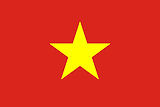
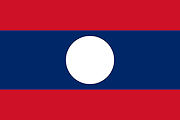
Radio Beijing, Pathet Lao [ປະເທດລາວ] Radio und Radio Hanoi künden an, dass chinesische, laotische und nordvietnamesische kommunistische bewaffnete Kräfte revolutionäre Frontorganisationen in Thailand unterstützen, nämlich
- das Thai Independence Movement
- die Thai Patriotic Front
1964-11-01


US National Security Council Working Group:
"The consequences for Southeast Asia of Communist control in South Vietnam were seen as highly differentiated and by no means automatic. The "domino theory" was viewed as "over-simplified." The Working Group felt that it might apply "if, but only if, Communist China . . . entered Southeast Asia in force and/or the United States was forced out of South Vietnam, in circumstances of military defeat." Nevertheless, the group judged that "almost immediately," Laos would become extremely hard to hold and Cambodia would be "bending sharply to the Communist side." These developments were seen as placing great pressure on Thailand and encouraging Indonesia to increase its pressure on Malaysia. Thailand, it was noted, had "an historic tendency to make 'peace' with the side that seems to be winning," and Malaysia's "already serious Malay-Chinese problem" was cited. The Working Group concluded: We could do more in Thailand and with the British in Malaysia to reinforce the defense of these countries, the initial shock wave would be great [sic]. . ."
[Quelle: Pentagon Papers. -- https://www.mtholyoke.edu/acad/intrel/pentagon3/pent5.htm. -- Zugriff am 2013-12-04]
1964-11-03

Lyndon B. Johnson (1908 - 1973) wird mit überwältigender Mehrheit zum Präsidenten der USA wiedergewählt.
Abb.: Lyndon B. Johnson nach dem Wahlsieg, 1964-11-03
[Bildquelle: Cecil Stoughton / Wikimedia. -- Public domain]
1964-11-04
Ca. 5000 Dörfler aus der Amphoe Sri Maha Phot (ศรีมหาโพธิ), Provinz Prachinburi (ปราจีนบุรี), fordern den Ministerpräsidenten auf, gegen Räuber und andere Kriminelle in ihrer Amphoe etwas zu unternehmen. Seit Jahresbeginn wurden in fünf Dörfern ca. 300 Personen ermordet. Raubüberfälle auf Arbeiter, die mit ihrem Tageslohn nach Hause gehen, sind üblich.
Abb.: Lage von Sri Maha Phot (ศรีมหาโพธิ)
[Bildquelle: OpenStreetMap. -- Creative Commons Lizenz (Namensnennung, share alike)]
1964-11-04
Bei einer Polizeirazzia in Bangkok werden 1638 Personen aufgegriffen, die im Verdacht stehen, "Räuber, Mörder, Taschendiebe, Prostituierte, Drogenabhängige, Einbrechen und andere Gesetzesbrecher" zu sein. Es werden u.a. ein gestohlenes Taxi, TV-Apparate, Radios, Gewehre und andere Waffen sichergestellt.
1964-11-08
Ein Friseur in Bangkok verkauft seine Frau an deren Liebhaber für 250 Baht. Er sei nicht fähig gewesen, seine Frau in den 10 Monaten seit ihrer Hochzeit zu befriedigen.
1964-11-16

Abkommen mit Japan über die Errichtung eines Centre for Highway Mechanical Devices in Südthailand.
1964-11-18
$32 Mio, die Ministerpräsident Sarit Thanarat (สฤษดิ์ ธนะรัชต์, 1908 - 1963) aus der Staatskasse geraubt hat, werden konfisziert.
1964-11-24
Ministerpräsident Thanom eröffnet "The Second Asian Writers' Conference" in Bangkok.
1964-12-01

Working group under Assistant Secretary of State William Bundy (1917 - 2000):
"We cannot guarantee to maintain a non-Communist South Vietnam short Of committing ourselves to whatever military action would be required to defeat North Vietnam and probably communist China militarily. Such a commitment would involve high risks of a major conflict in Asia, which could not be confined to air and naval action but would almost inevitably involve a Korean-scale ground action and possibly even the use of nuclear weapons at some point." [Zitat: http://europe.newsweek.com/authors/robert-s-mcnamara. -- Zugriff am 2016-07-01]
1964-12-02


USA: Position paper on Southeast Asia / prepared by the Executive Committee:
"C. Laos and Thailand The US Ambassadors in these countries will inform the government in general terms of the concept we propose to follow and of specific actions requiring their concurrence or participation. In the case of Laos, we will obtain RLG [Royal Lao Government] approval of an intensified program of US armed reconnaissance and air strikes both in the Panhandle area of Laos and along the key infiltration routes in central Laos. These actions will not be publicized except to the degree approved by the RLG. It is important, however, for purposes of morale in SVN [South Vietnam], that their existence be generally known.
Thailand will be asked to support our program fully, to intensify its own efforts in the north and northeast, and to give further support to operations in Laos, such as additional pilots and possibly artillery teams."
[Quelle: http://history.state.gov/historicaldocuments/frus1964-68v01/d433. -- Zugriff am 2013-12-04]
1964-12-03
Apasra Hongsakula (อาภัสรา หงสกุล, 1947 - ) wird Miss Thailand. Dies ist die erste Miss-Thailand-Wahl seit zehn Jahren. Die Wahlen waren seit 1959 ausgesetzt worden "because improper attentions had been illegally pressed on beauty finalists by a member of the government".
1964-12-09
Conference of Asian Statisticians in Bangkok.
1964-12-10
Eröffnung des japanische Kaufhauses Thai Daimaru in Bangkok. Das Kaufhaus hat die erste Rolltreppe Thailands.
1964-12-11
Ministerpräsident Thanom hält es für notwendig, dass Puey Ungphakorn (ป๋วย อึ๊งภากรณ์ = 黃培謙, 1966 - 1999) neben seinem Amt als Dekan an der Thammasat Universität (มหาวิทยาลัยธรรมศาสตร์) Governor der Bank of Thailand (ธนาคารแห่งประเทศไทย) bleibt.
Abb.: Denkmal für Dr. Puey Ungphakorn (ป๋วย อึ๊งภากรณ์ = 黃培謙), 6 October 1976 Massacre Memorial at Thammasat University, Bangkok
[Bildquelle: Xiengyod / Wikipedia. -- GNU FDLicense]
"Puey Ungpakorn, MBE (Thai: ป๋วย อึ๊งภากรณ์, Chinese: 黃培謙,[1] March 9, 1916 - July 28, 1999) was an extremely successful bureaucrat who played a central role in the shaping of Thailand's economic development and in the strengthening of its system of higher education. Puey was the Governor of the (Central) Bank of Thailand for 12 years, a Dean of the Faculty of Economics, and also a rector of Thammasat University in Bangkok. Puey was a member of the Free Thai Movement (ขบวนการเสรีไทย) during World War II. He was a Magsaysay Award winner in the field of public service in 1965. Puey is the author of The Quality of Life of a South-East Asian: A Chronicle of Hope from Womb to Tomb or later known as From Womb to Tomb, which is still one of the most influential writings about social security in Thailand.
Early yearsPuey was born the fourth child of an immigrant Chinese fishmonger and a second generation Thai-Chinese mother, with ancestry from Raoping (饶平县).[2] In 1934 he was among the first group of students to enrol at the newly opened Thammasat University, which he graduated from in 1937. After having briefly worked as a translator Puey earned a government scholarship to study economics at the London School of Economics in 1938.
Following the outbreak of the Pacific War in December 1941, Puey joined the Free Thai Movement in Britain, and having undergone vigorous training with the Special Operations Executive, parachuted into northern Thailand in late 1944. He was captured almost immediately, and remained technically a prisoner of war until the Japanese surrender in September 1945, though he in fact made contact with Free Thai members of the Thai police and was able to work with them from his jail cell.
After the war, Puey was promoted to the rank of lieutenant colonel in the British forces and was awarded an MBE. He resumed his studies, and in 1949 received one of Thailand's first Ph.D.'s in Economics from the London School of Economics.
BOT governorWhen he became Governor of the Bank of Thailand, Puey quickly attracted the attention of international agencies, foreign governments, and the international financial community for the integrity of his financial planning and management. His international stature was recognised ceremoniously in 1964 when he became the first Thai to receive the Magsaysay Award for public service. Equally important, this international recognition gave him an influence with Field Marshals Sarit Thanarat, Thanom Kittikachorn, and their cohorts which far exceeded his bureaucratic position. They sought his aid and advice as a trouble-shooter for Thailand's monetary interests, particularly in matters they had botched or in which they were suspected to have their own private interests, such as remedying Sarit's mishandling of Thailand's participation in an International Tin Council and preventing a kickback scandal over the foreign printing of Thailand's currency.
Academic careerIn 1966 Puey became the dean of the Faculty of Economics at his alma mater, Thammasat University, where his work with the Rockefeller Foundation and with foreign scholars dramatically upgraded the training of Thailand's future technocrats. He also instituted a long-term research project on raising the productivity and economic level of Thai villagers. It was during this period that he was invited to serve as a visiting professor at both Cambridge and Princeton universities and was appointed to the governing boards of such organisations as the International Council for Educational Development, the East-West Centre, the Asian Institute of Management, and the International Food Policy Research Institute.
After the ousting of Thanom's regime in October 1973, Puey was catapulted into political prominence and, along with M.R. Kukrit Pramoj, was broadly promoted as one of the two major candidates for the post of prime minister in the elected government that would follow the palace-picked interim administration of Sanya Thammasak (สัญญา ธรรมศักดิ์). However, after a great deal of self-examination, Puey disavowed all interest in such a candidacy and returned to Thammasat, where he was appointed rector. Puey's explanation was that when he had joined the Free Thai Movement he had taken an oath never to seek or accept political appointment until after reaching the age of retirement. Some have argued, however, that Puey's withdrawal was based upon his mature understanding of the nature of society and that he had accurately foreseen that the upcoming democratic period would be inherently unstable, dangerous and short-lived.
ExileDespite his service, honesty and international reputation, Puey was branded a communist and "destroyer of unity" by the political right of Thailand. Although he spoke out against the unending student demonstrations of 1975-76 as being both ineffective and self-destructive, and even denied his students any use of the Thammasat campus as a base for mounting public demonstrations, he was nevertheless assigned blame for their occurrence.
On the evening of the bloody 6 October 1976 Massacre, Puey resigned from his position as rector of Thammasat in protest against the bloodbath that had occurred that day on the university campus. Realising he was a marked man, Puey went to Don Muang airport where he was met by a lynch mob. Only with the help of the Royal Thai Air Force police, who had been instructed by King Bhumibol's privy council office to help him leave, did he evade death and get on a plane bound for London.[3]
While living abroad, Puey met with Thais and influential figures in several countries, including those in the United Kingdom, the United States, France, Germany, Sweden, Denmark, Japan, and Australia to give facts on the incident and to call for a peaceful transition to democracy in Thailand. In 1977, Puey gave testimonials before the House Committee on Foreign Affairs investigating human rights in Thailand following the incident of 6 October 1976 Massacre.
In September 1977, Puey suffered a haemorrhagic stroke and had to stay in the hospital for three months. The illness left Puey with speech difficulties in which he could mumble only minimally. Puey lived a simple life in England to the end of his life. He could walk by himself. While he spoke only little, he could get his will communicated to the surrounding people. As a result of the stroke, he was not able to control his right hand."
[Quelle: http://en.wikipedia.org/wiki/Puey_Ungphakorn. -- Zugriff am 2011-11-10]
1964-12-11
Eröffnung einer Raffinerie Thai Oil Refinery Company (TORC) in Si Racha (ศรีราชา)
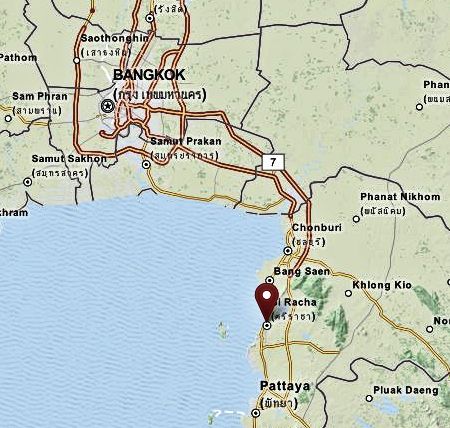
Abb.: Lage von
Si Racha (ศรีราชา)
[Bildquelle: OpenStreetMap. --
Creative Commons Lizenz (Namensnennung, share alike)]
1964-12-14 - 1964-12-21

Staatsbesuch Kronprinz Akihito (明仁, geb. 1933) von Japan mit Gattin Michiko Shōda (正田 美智子, 1934 - ).
Abb.: Kronprinz Akihito (明仁) mit Gattin Michiko Shōda (正田 美智子)
[Bildquelle: Wikipedia. -- Public domain]
Abb.: Lage von Japan
[Bildquelle: OpenStreetMap. -- Creative Commons Lizenz (Namensnennung, share alike)]
1964-12-14 - 1973-03-29


Operation Barrel Roll: von Nakhon Phanom (นครพนม) aus wird Laos von amerikanischen Söldnern bombardiert.
Abb.: Nakhon Phanom Royal Air Force Base zur völkerrechtswidrigen Bombardierung von Laos, 1960er Jahre
[Bildquelle: USAF / Wikipedia. -- Public domain]
Abb.: Lage der Nakhon Phanom Royal Air Force Base
[Bildquelle: OpenStreetMap. -- Creative Commons Lizenz (Namensnennung, share alike)]
Abb.: Laos: routes and areas struck in first Barrel Roll missions December 1964
[Bildquelle: USAF / Van Staaveren, Jacob: Interdiction in southern Laos, 1960-1968 : the United States Air Force in Southeast Asia. -- Washington, D.C. : Center for Air Force History, 1993. -- 360 S. : Ill. ; 24 cm. -- S. 45. -- Public domain]
"Operation Barrel Roll was a covert U.S. Air Force 2nd Air Division (later the Seventh Air Force) and U.S. Navy Task Force 77, interdiction and close air support campaign conducted in the Kingdom of Laos between 14 December 1964 and 29 March 1973 concurrent with the Vietnam War. The original purpose of the operation was to serve as a signal to the Democratic Republic of Vietnam (North Vietnam) to cease its support for the insurgency then taking place in the Republic of Vietnam (South Vietnam). This action was taken within Laos due to the location of North Vietnam's expanding logistical corridor known as the Ho Chi Minh Trail (the Truong Son Road to the North Vietnamese), which ran from southwestern North Vietnam, through southeastern Laos, and into South Vietnam. The campaign then centered on the interdiction of that logistical system. Beginning during the same time frame (and expanding throughout the conflict) the operation became increasingly involved in providing close air support missions for Royal Lao Armed Forces, CIA-backed tribal mercenaries, and Thai "volunteers" in a covert ground war in northern and northeastern Laos. Barrel Roll and the "Secret Army" attempted to stem an increasing tide of People's Army of Vietnam (PAVN) and Pathet Lao offensives."
[Quelle: http://en.wikipedia.org/wiki/Operation_Barrel_Roll. -- Zugriff am 2013-08-19]
Abb.: Eines der unzähligen "Denkmale" US-thailändischer Kriegsverbrechen in Laos: dieses Feld ist noch 2010 von unzähligen Streubomben (markiert) bedeckt, mit denen US-Söldner weite Teile von Nordostlaos abgedeckt haben
[Bildquelle: Anna Macdonald/Oxfam International. -- http://www.flickr.com/photos/8470194@N02/5168825602. -- Zugriff am 2013-08-19. -- Creative Commons Lizenz (Namensnennung, keine kommerzielle Nutzung, keine Bearbeitung)]
ausführlich: http://www.payer.de/thailandchronik/ressourcen.htm
Zu Chronik 1965